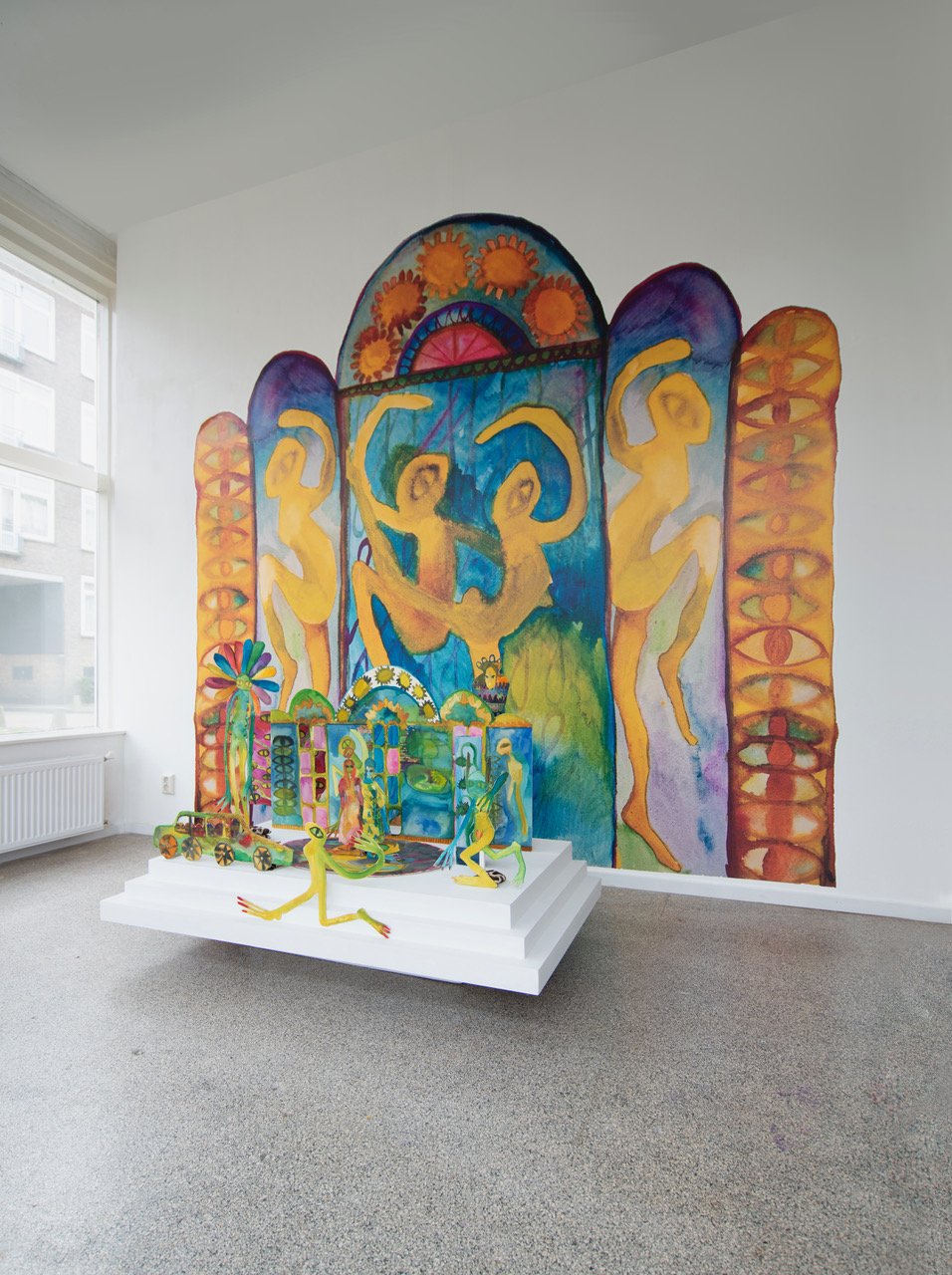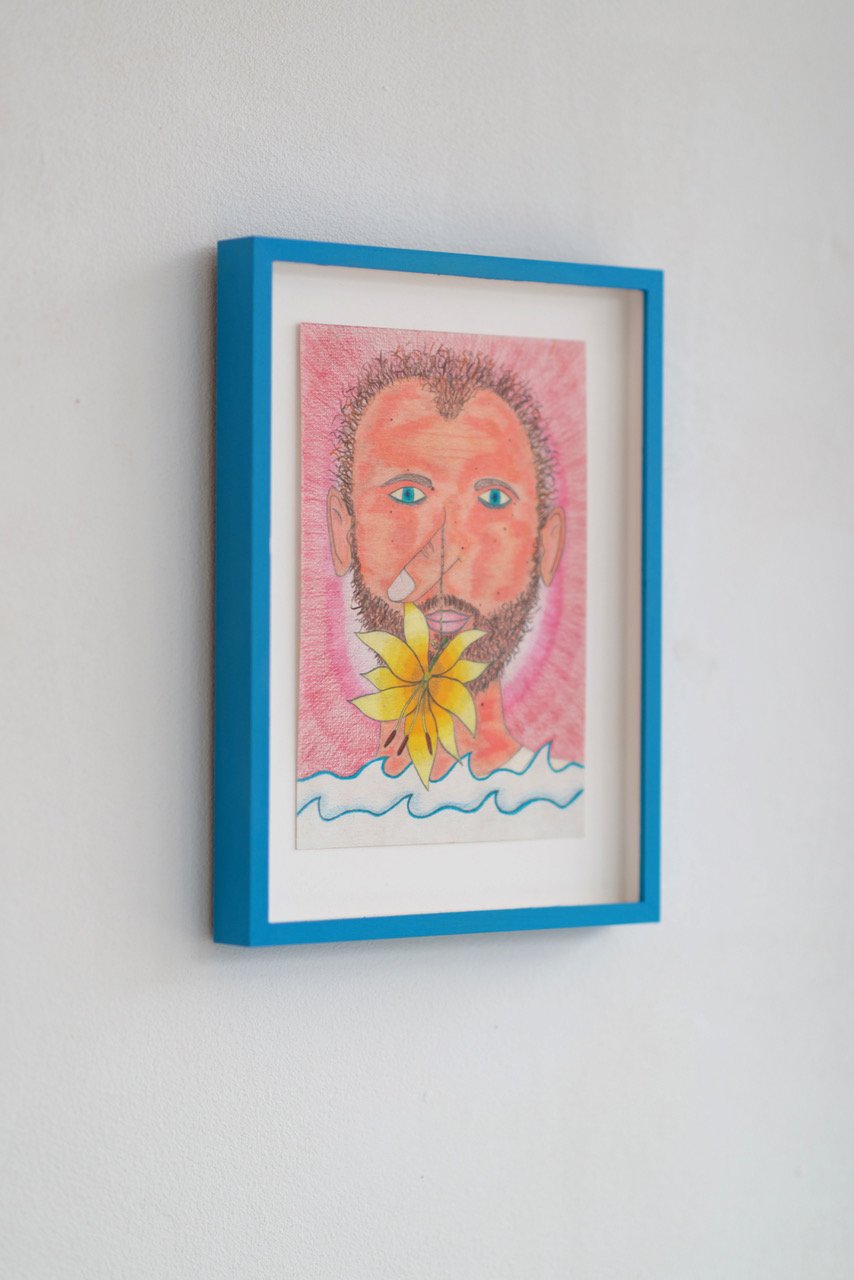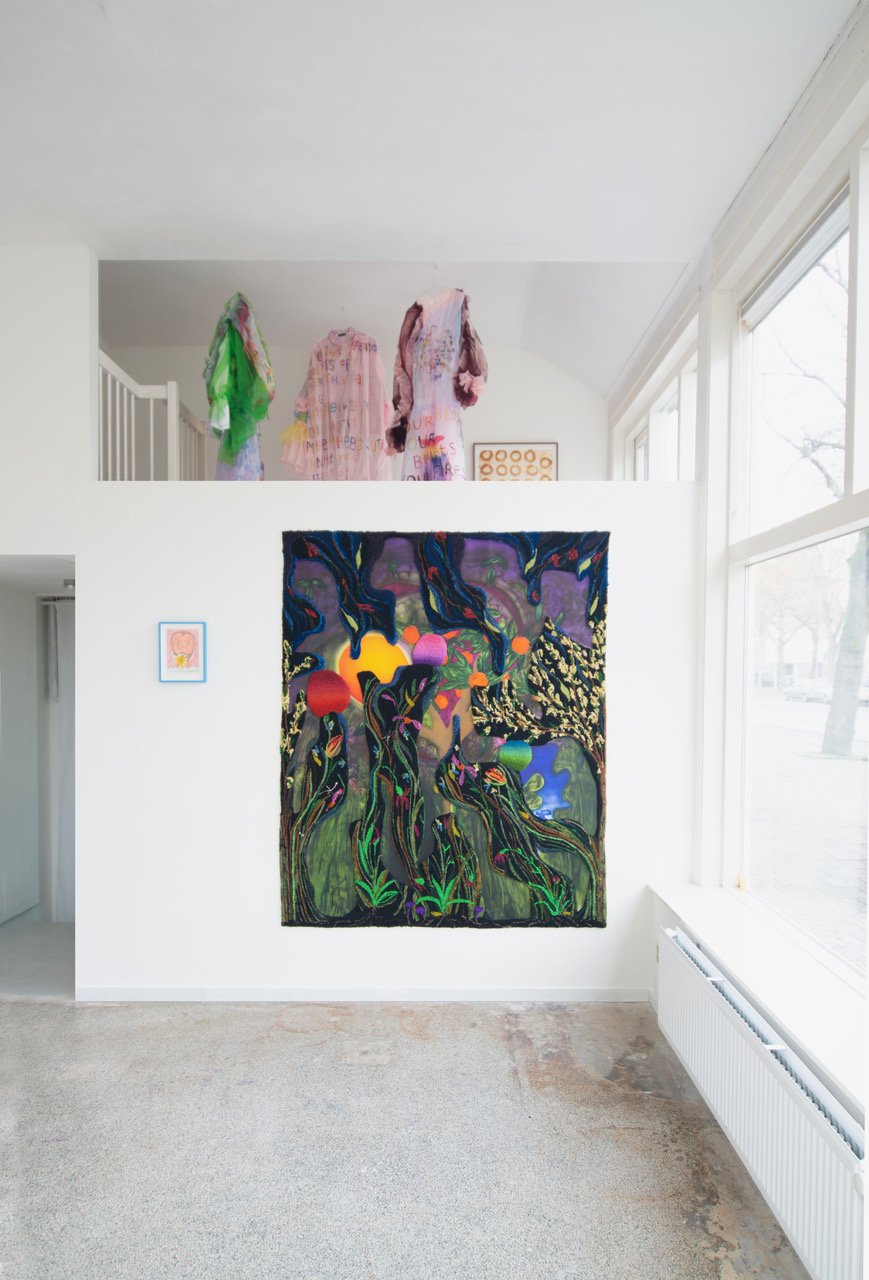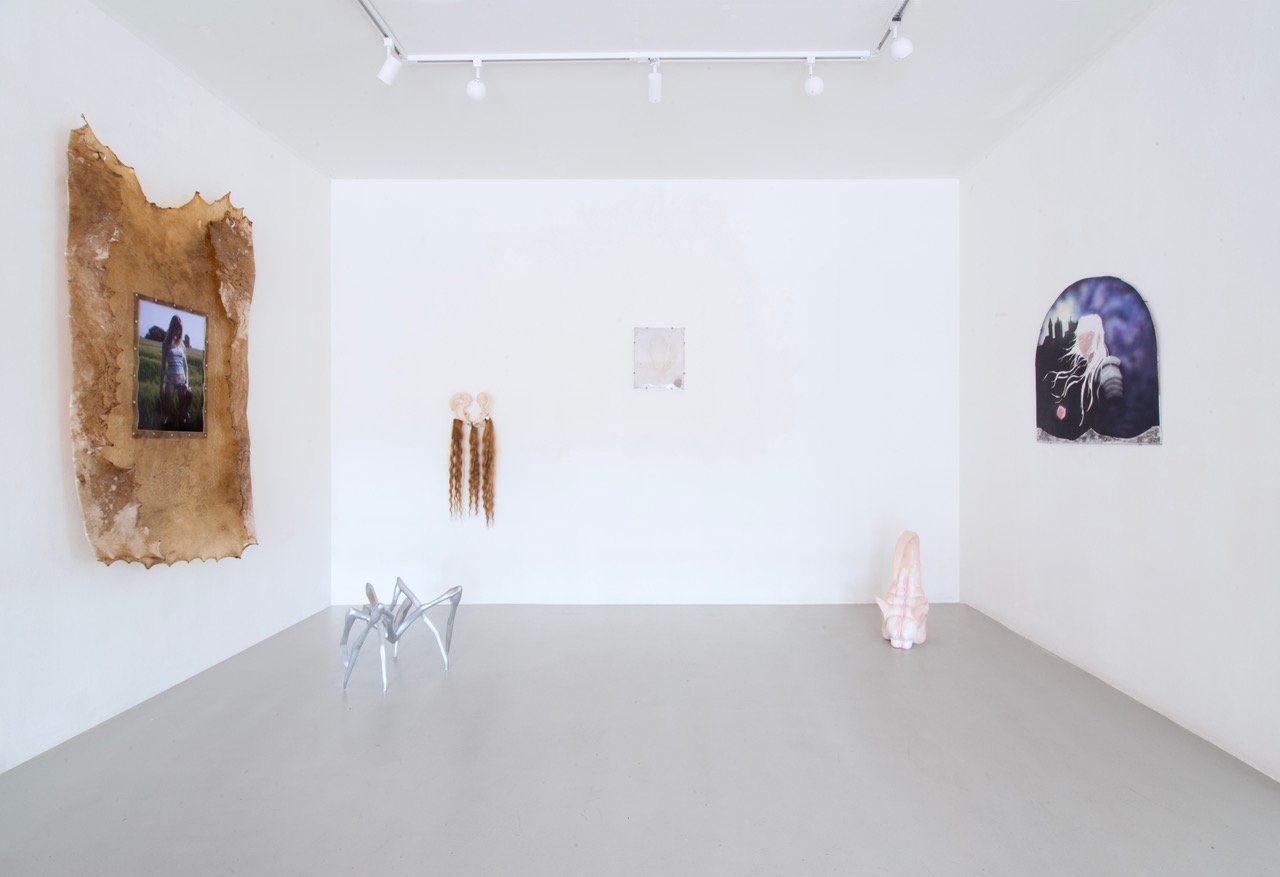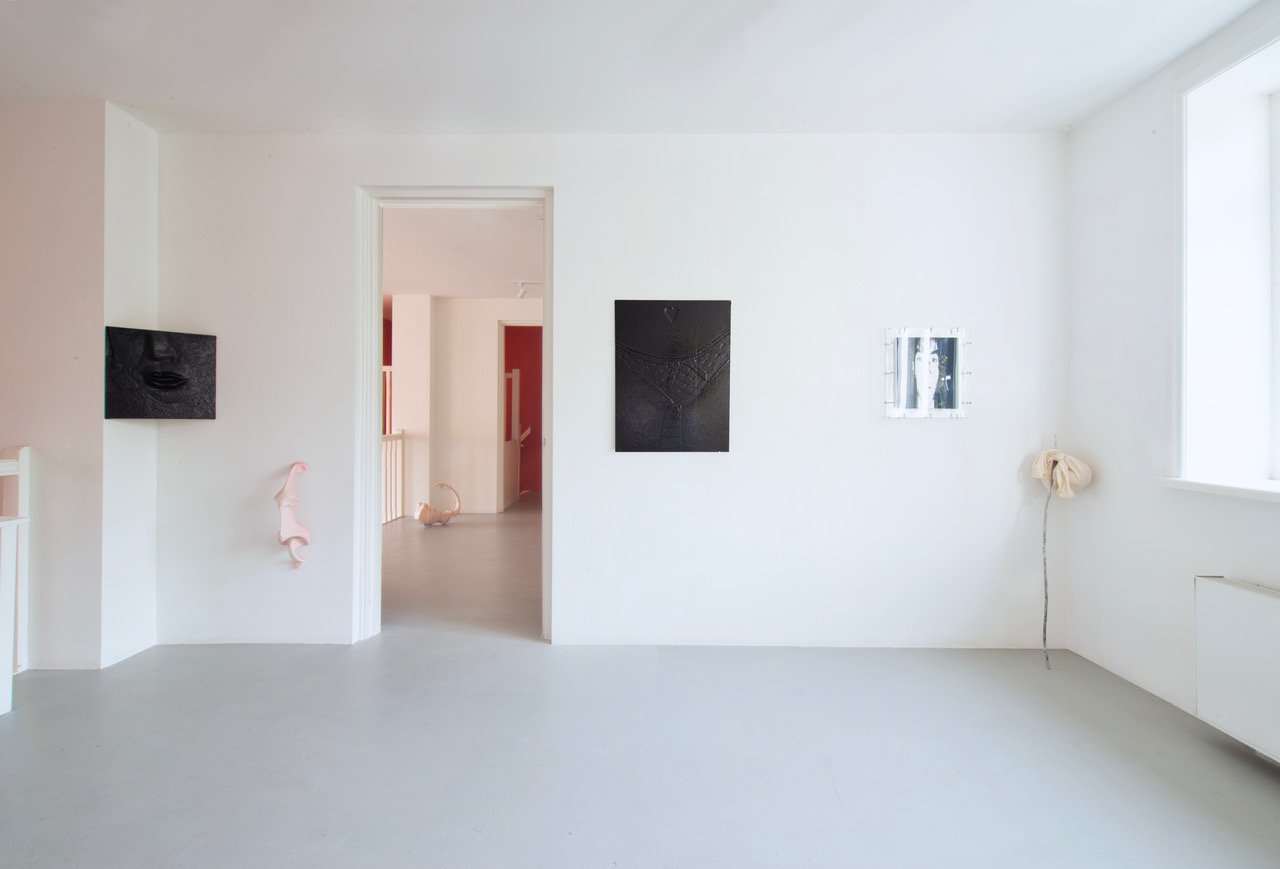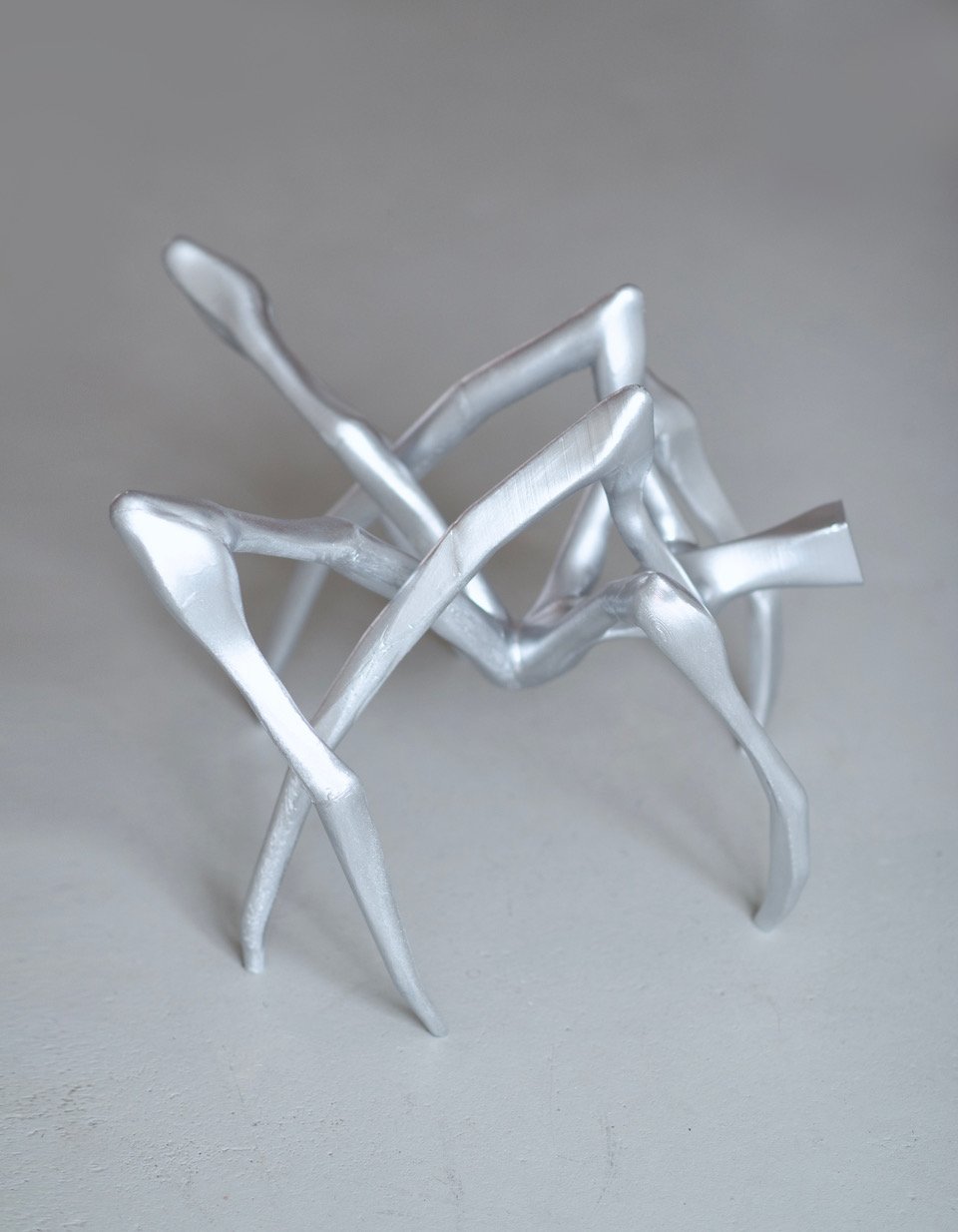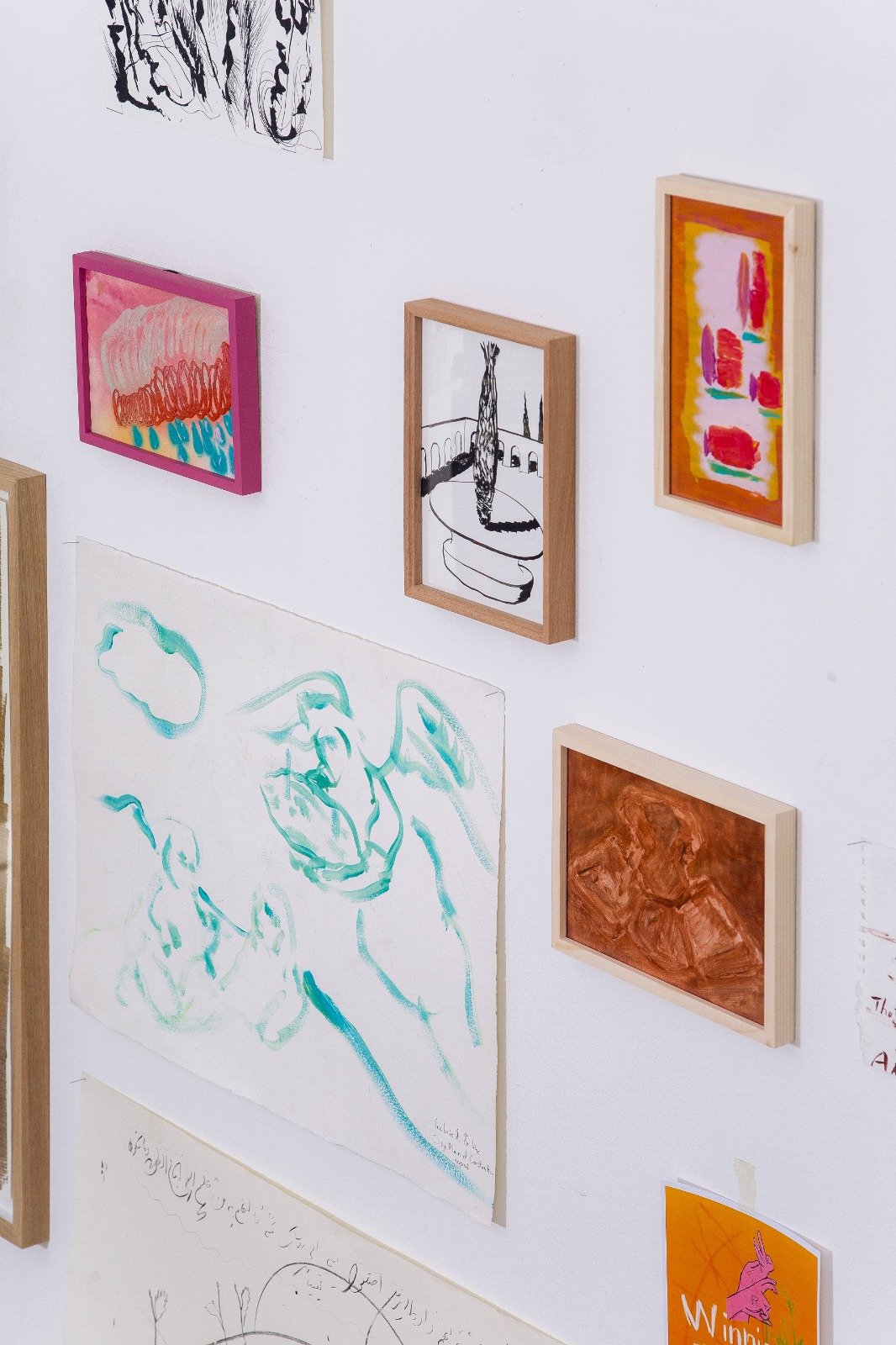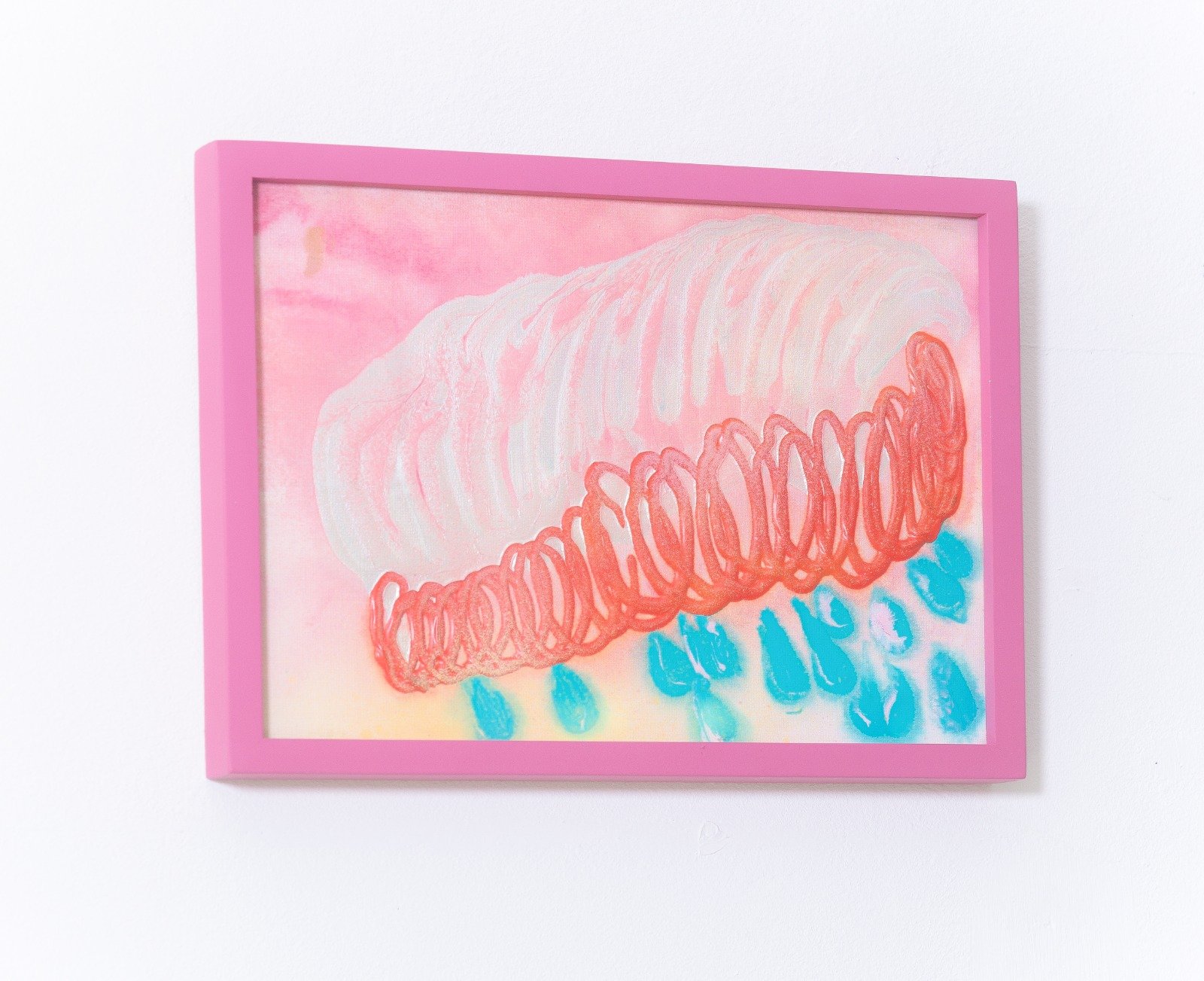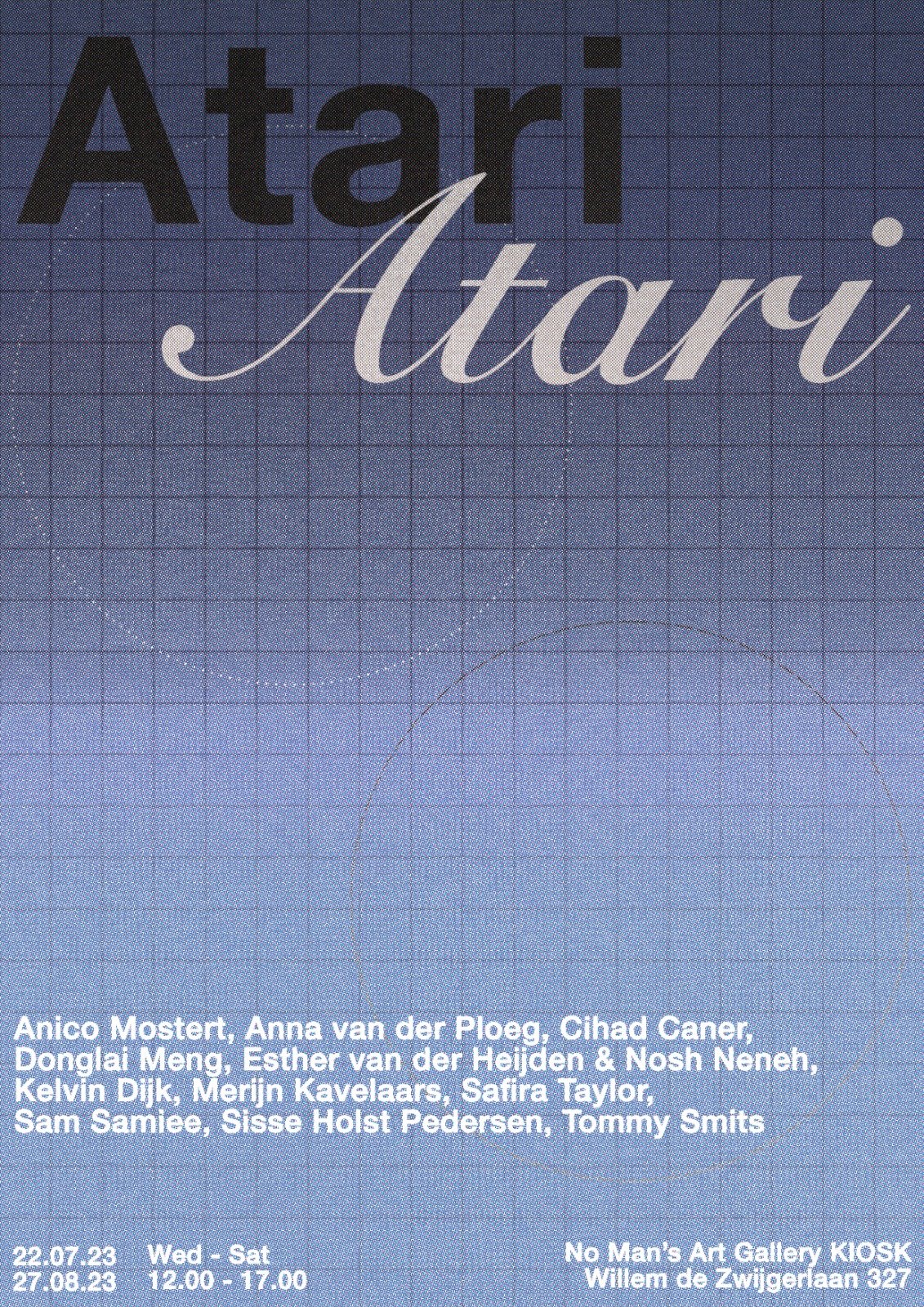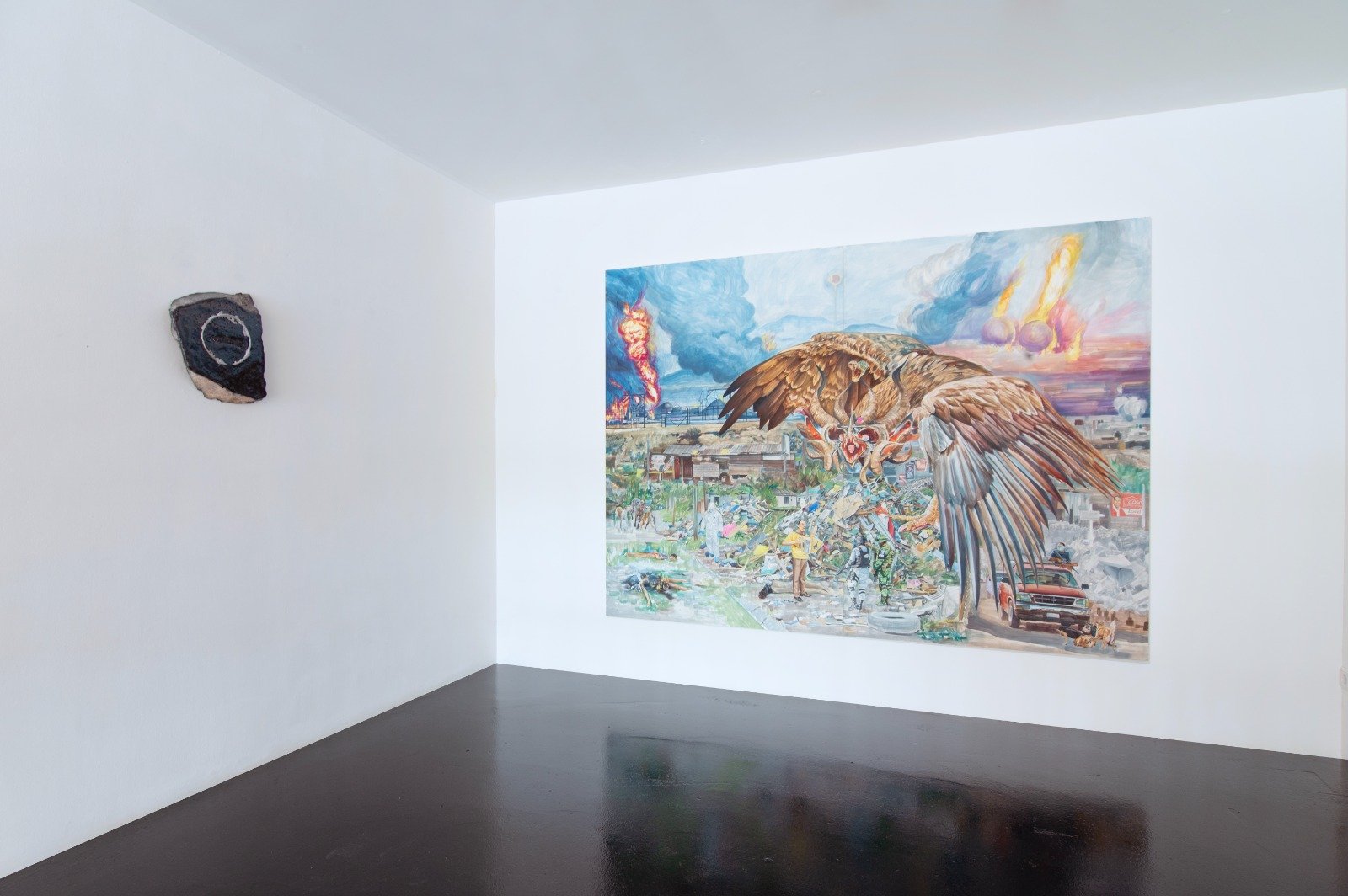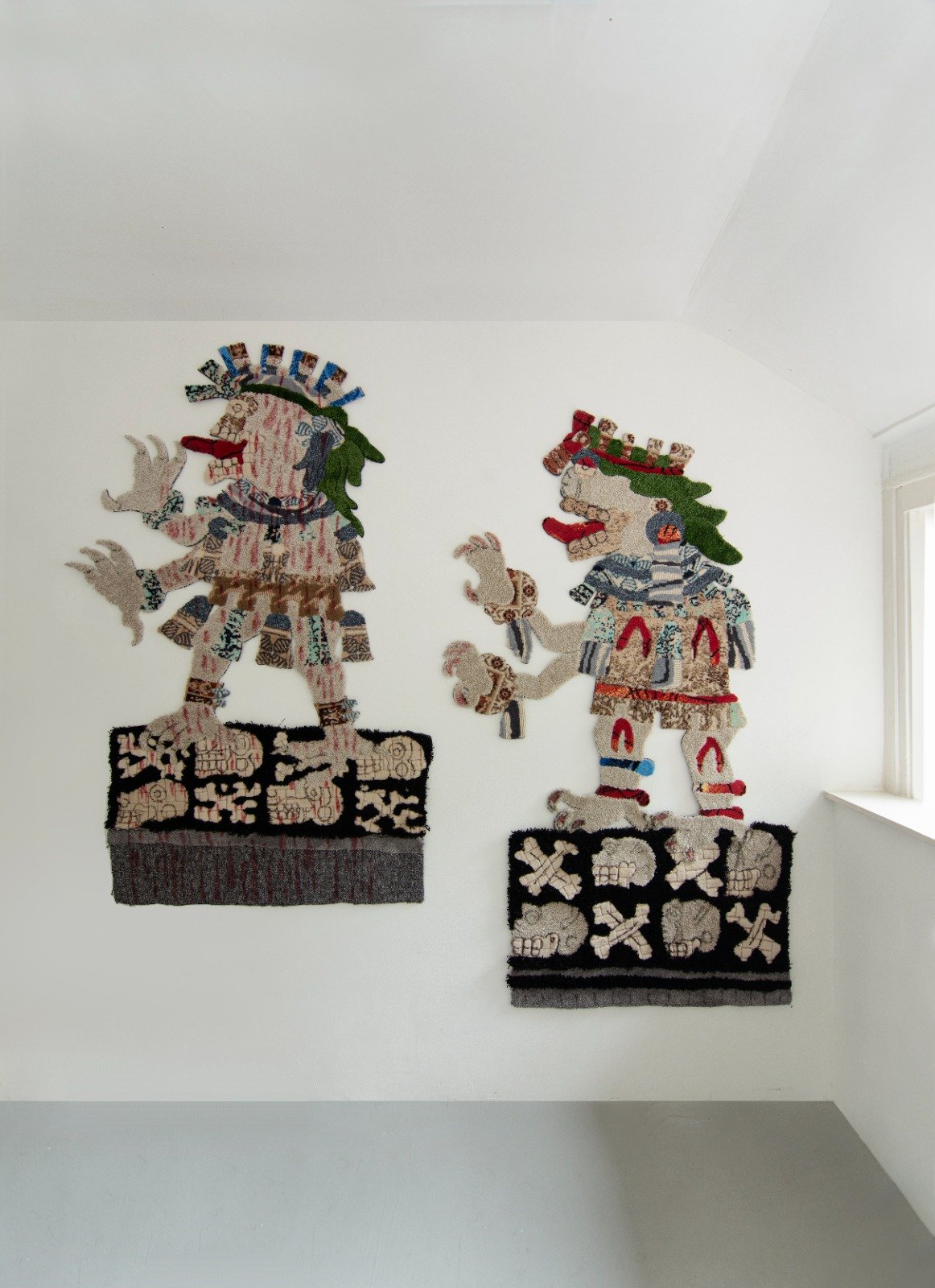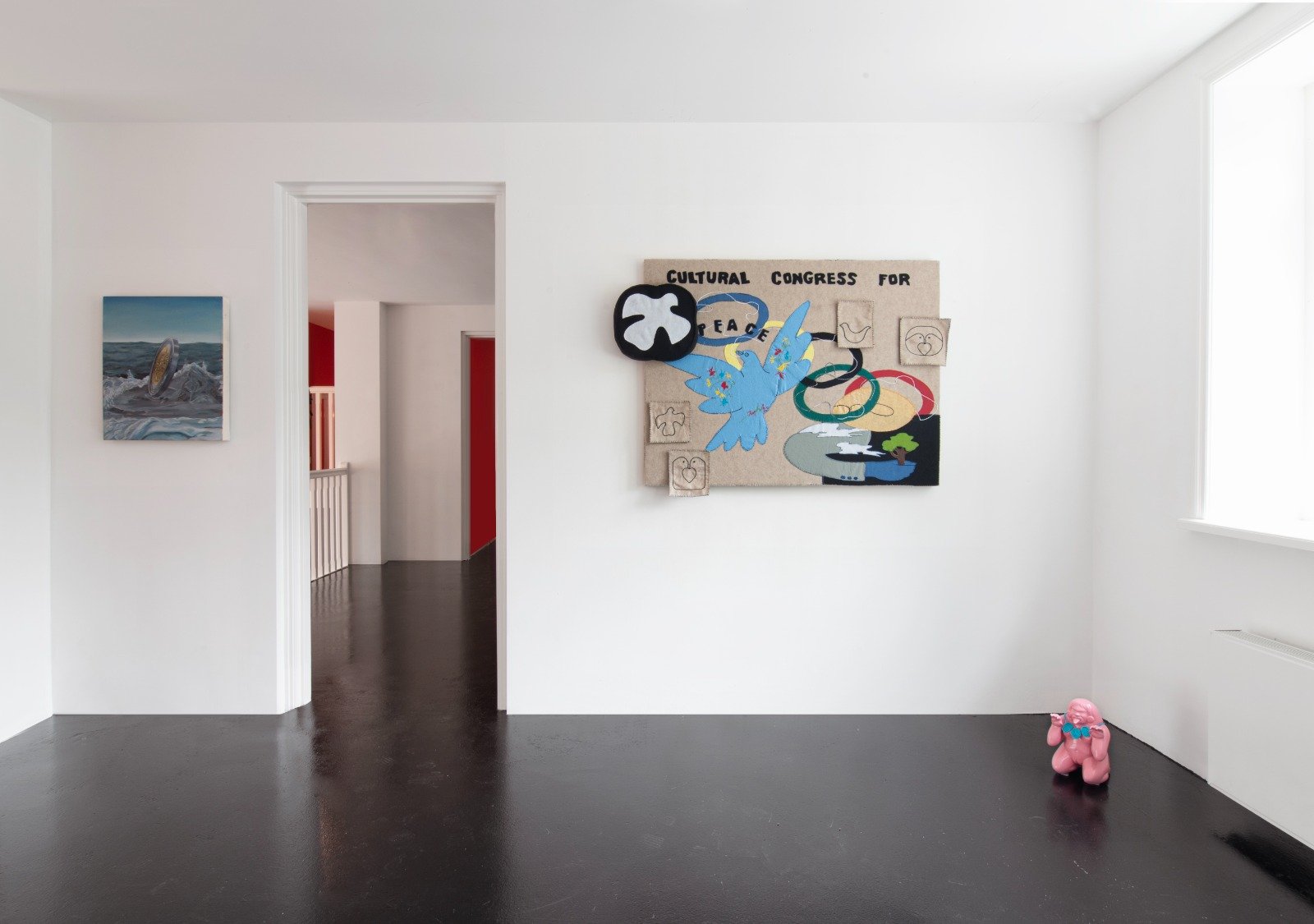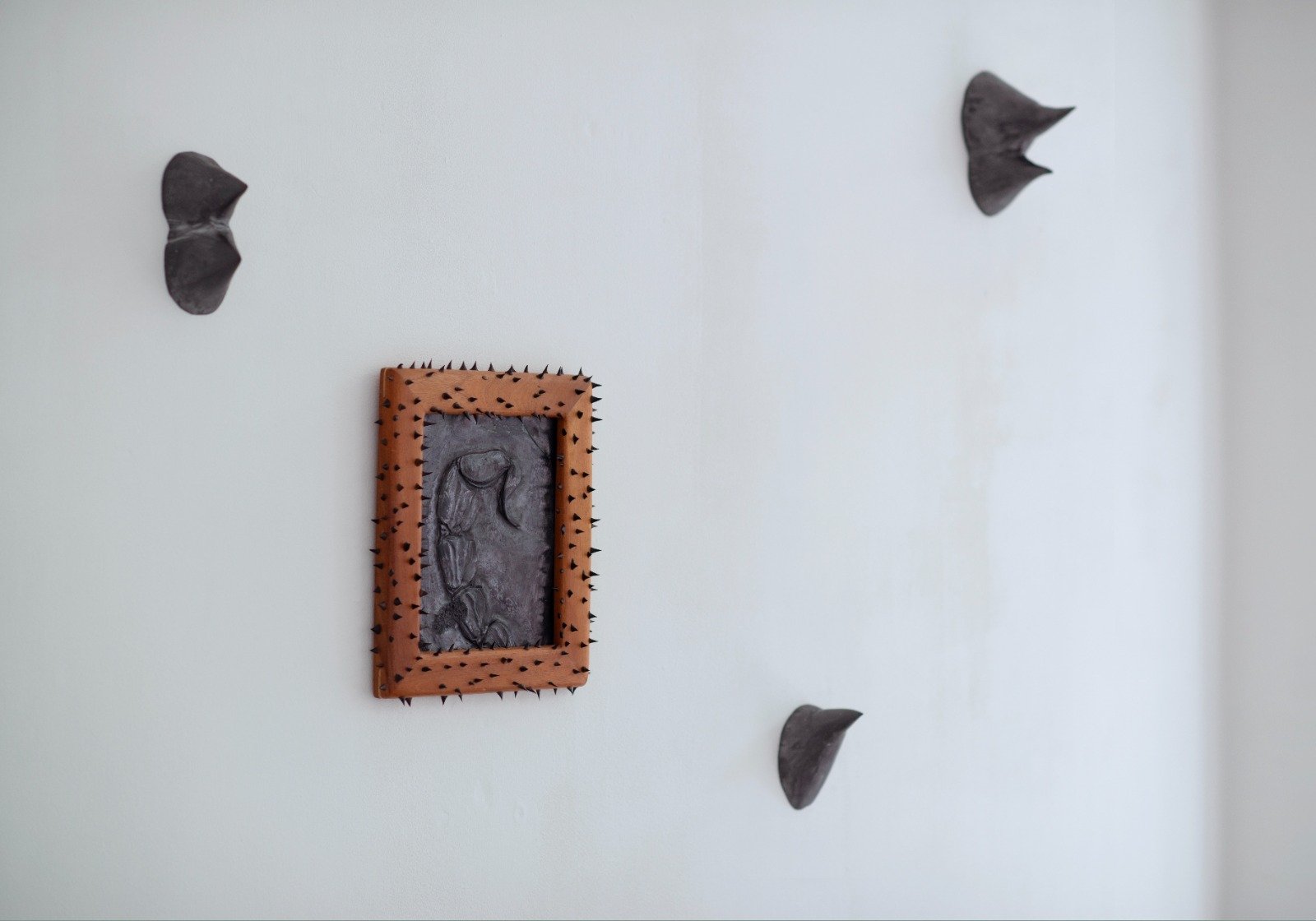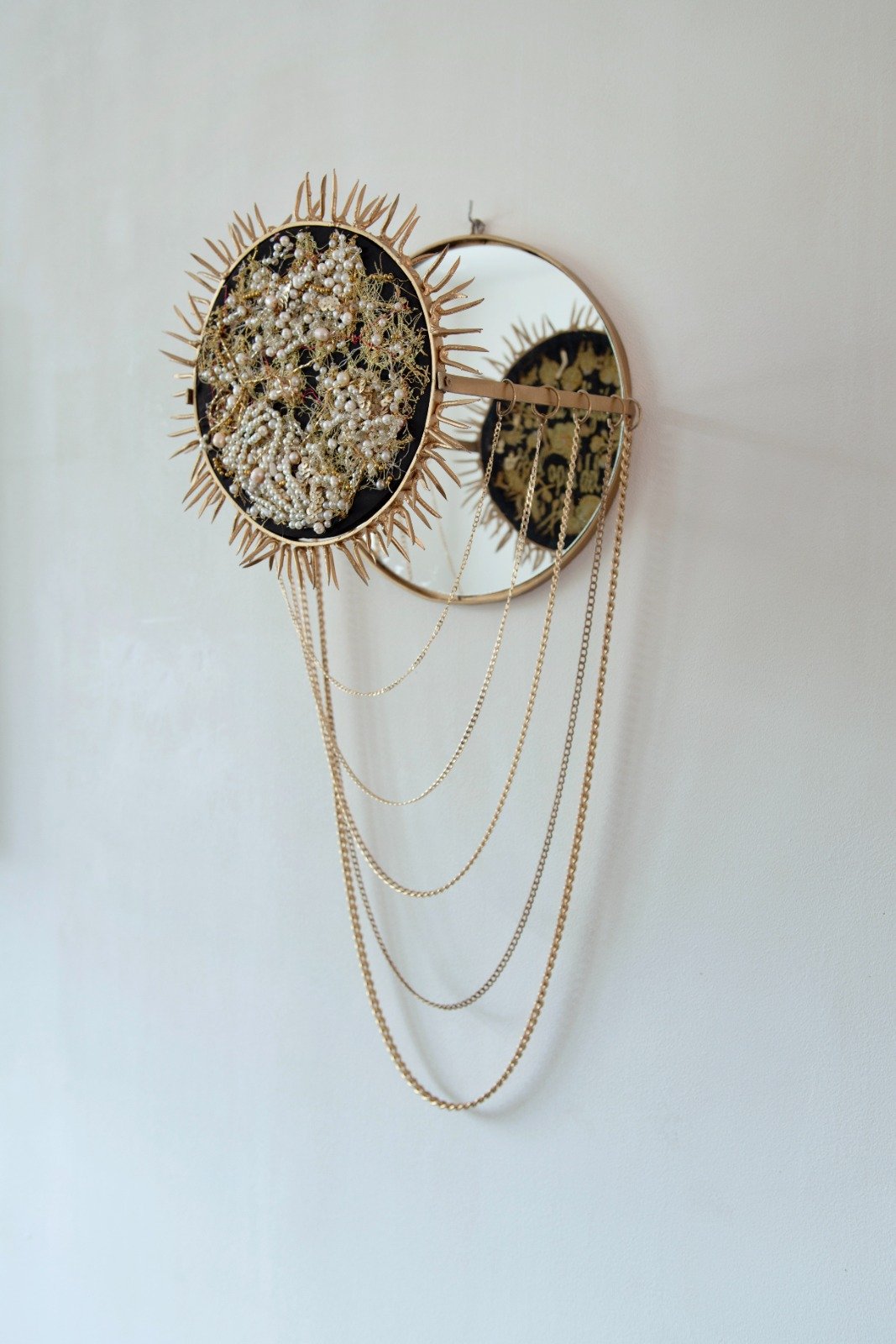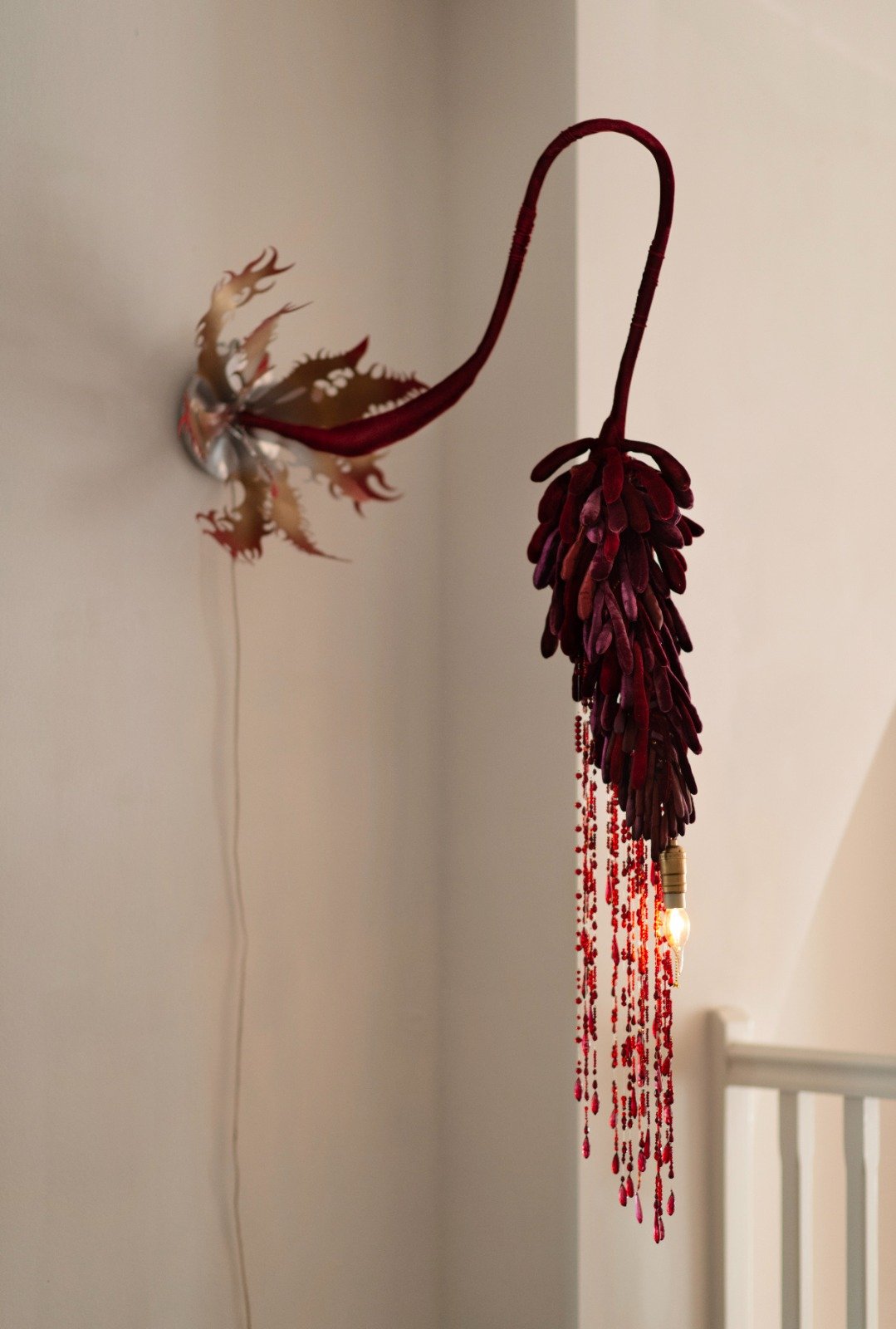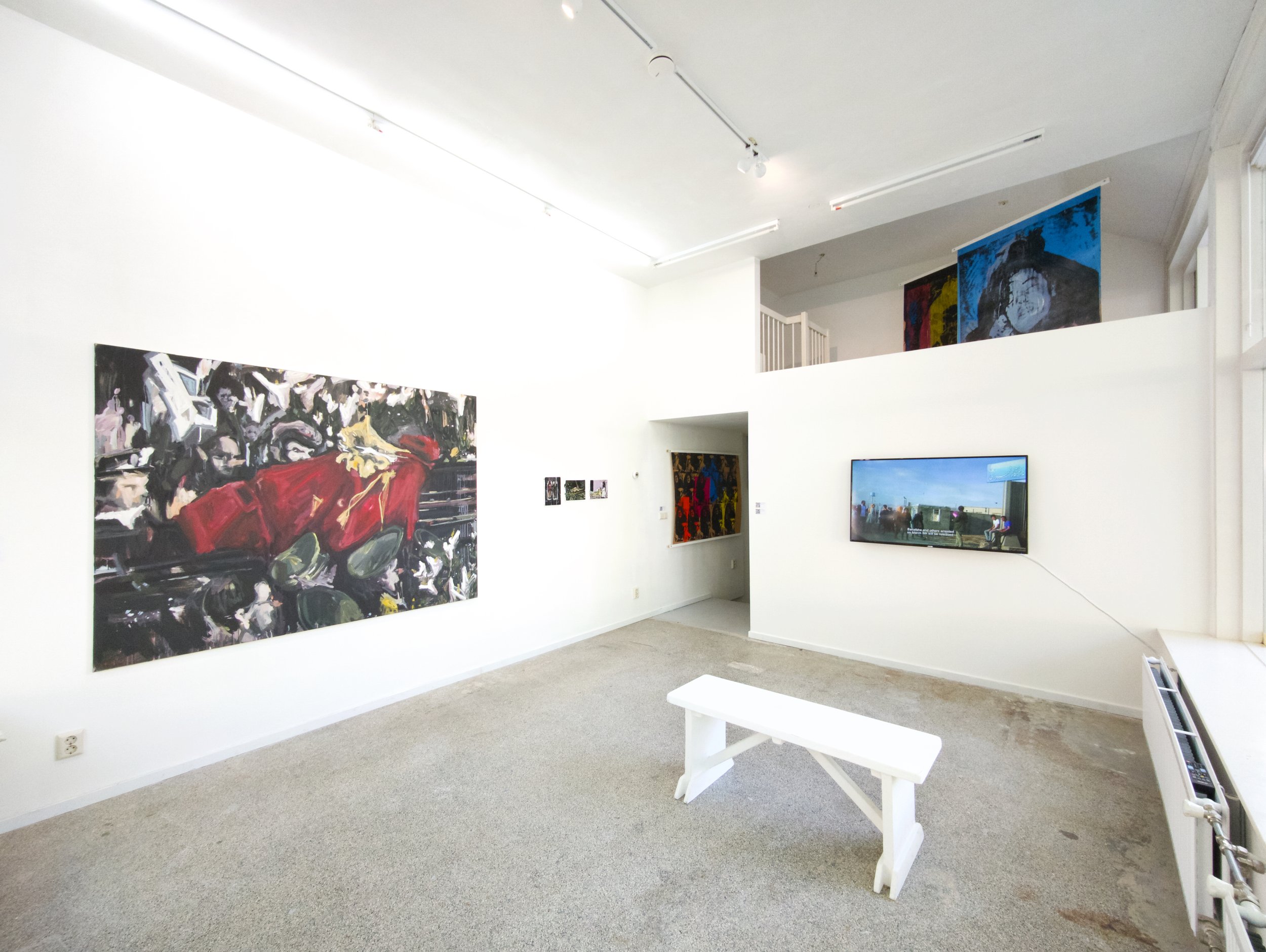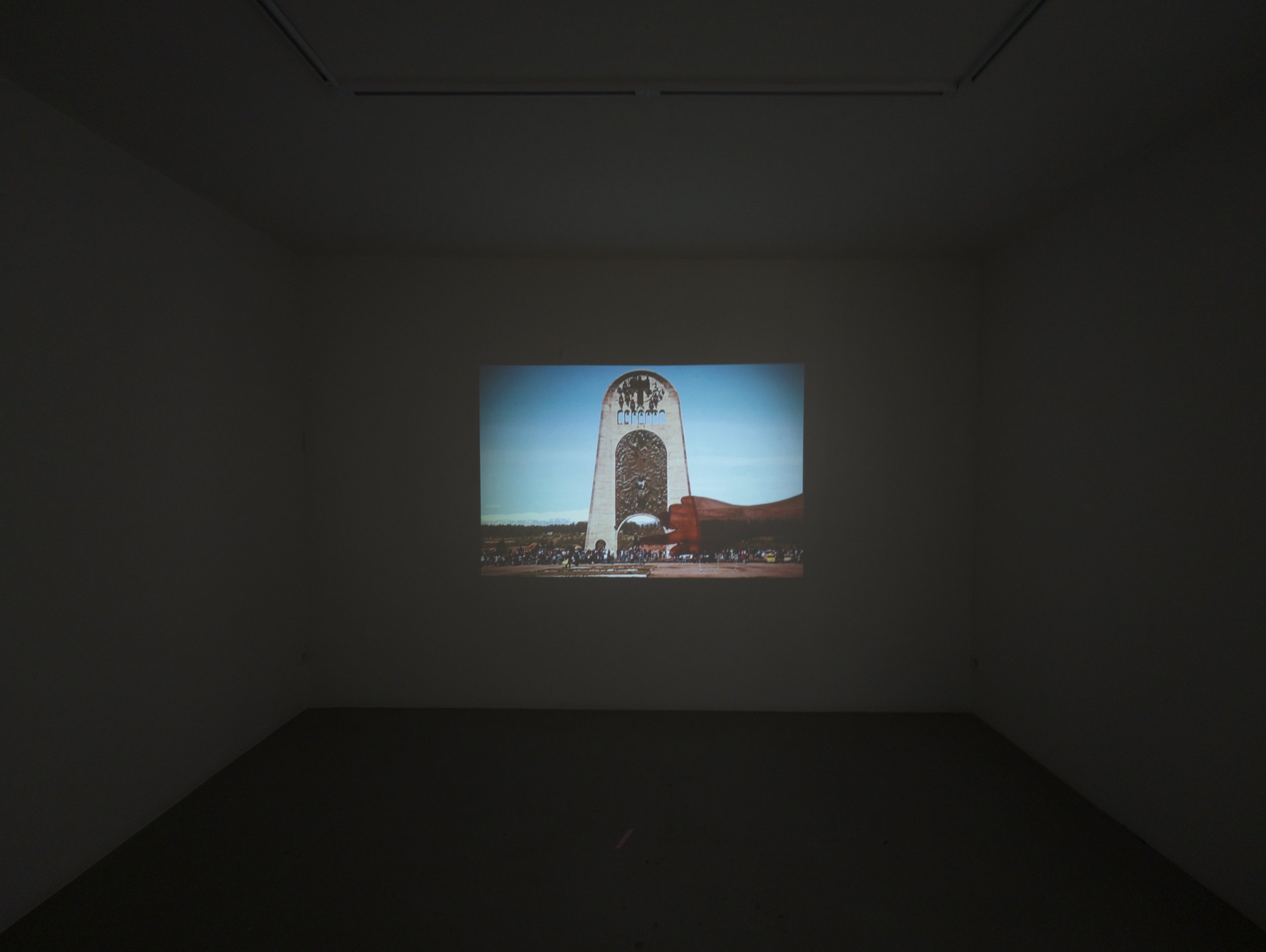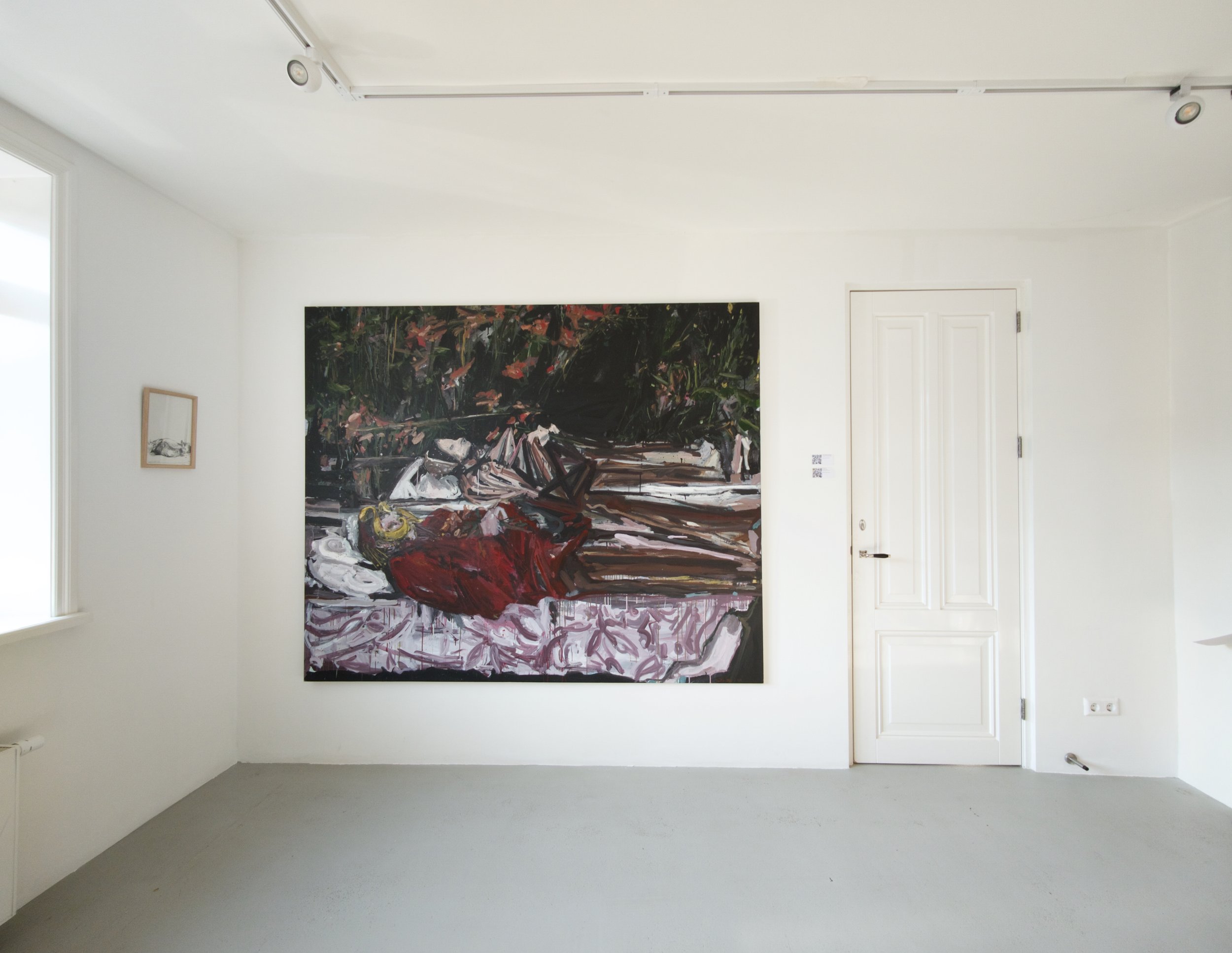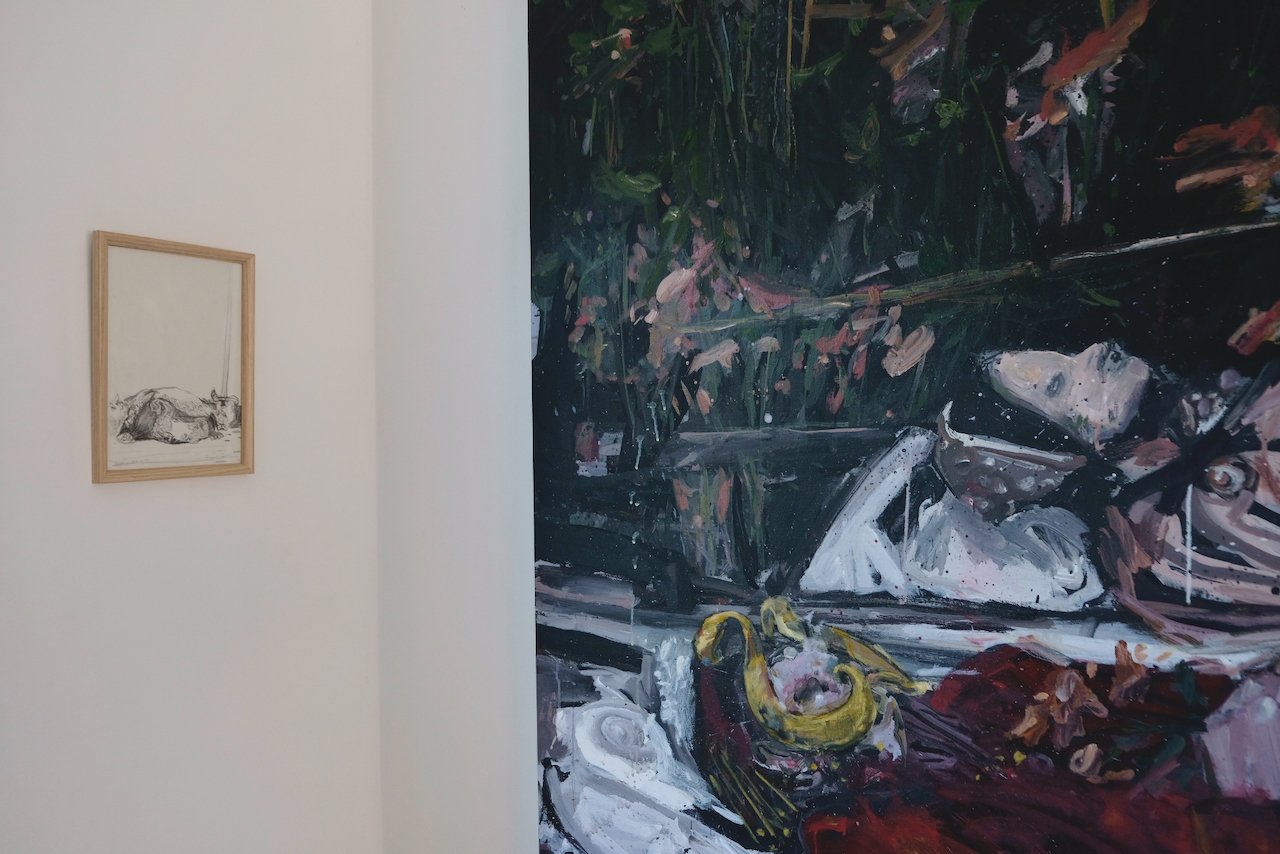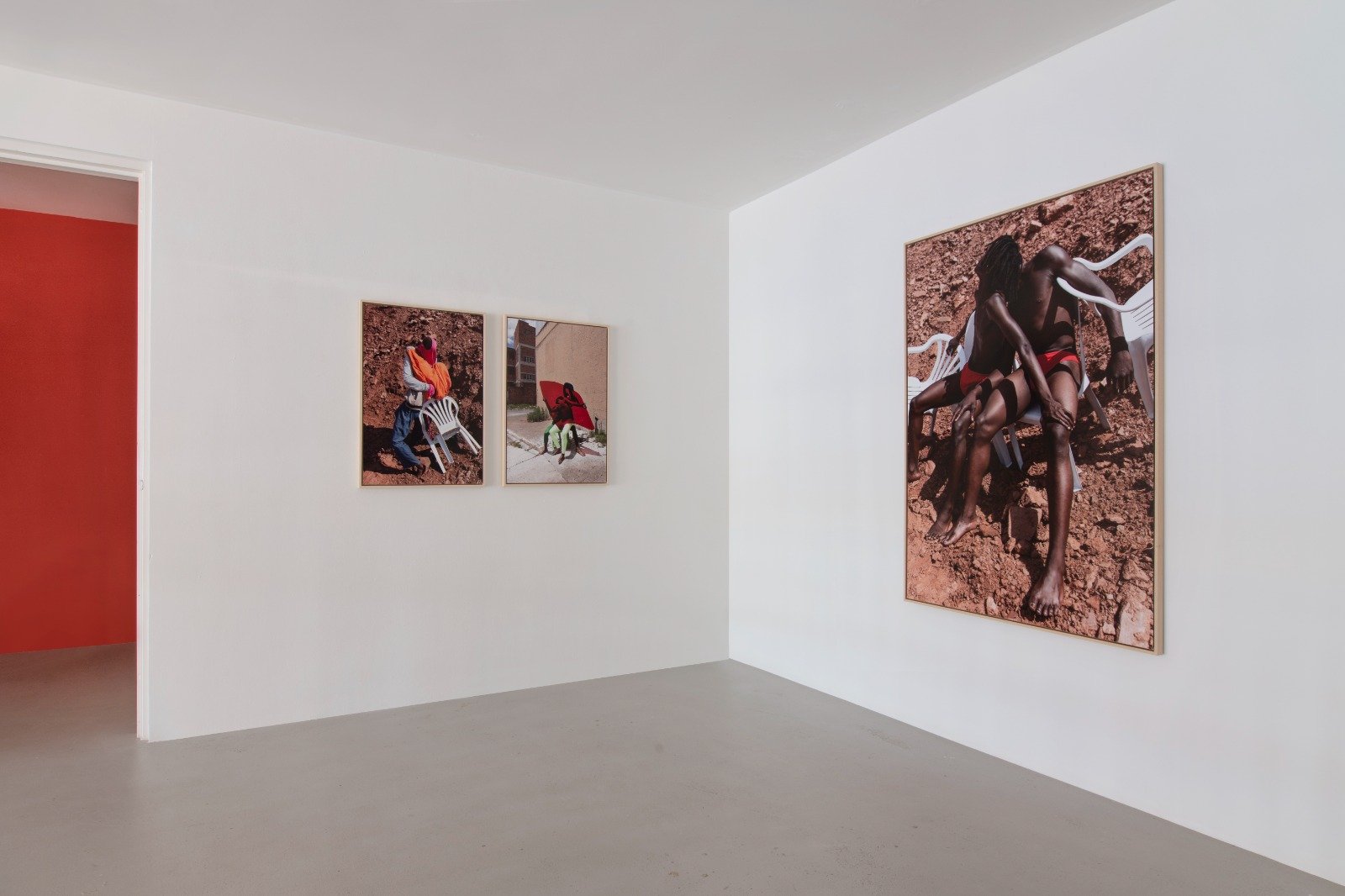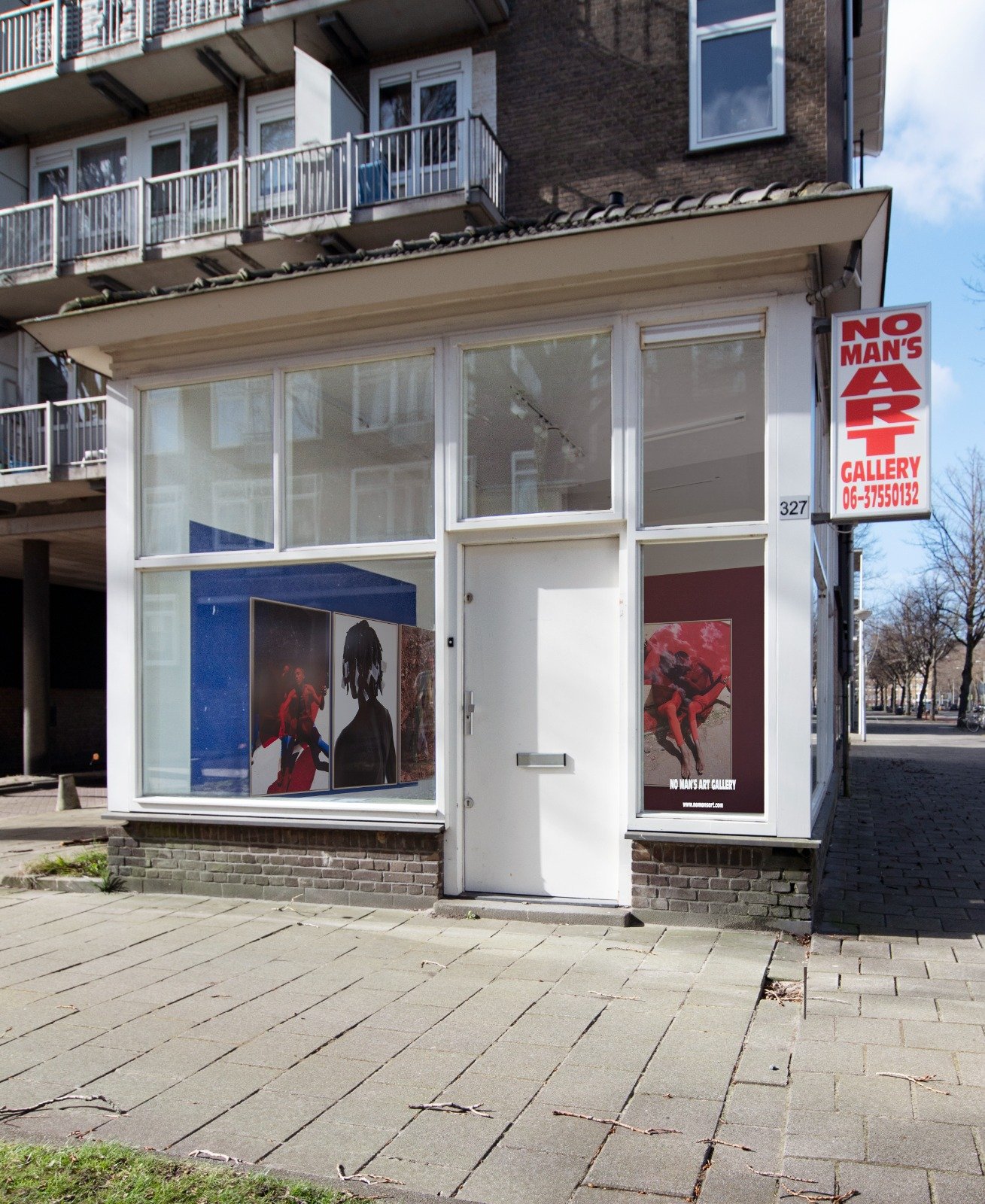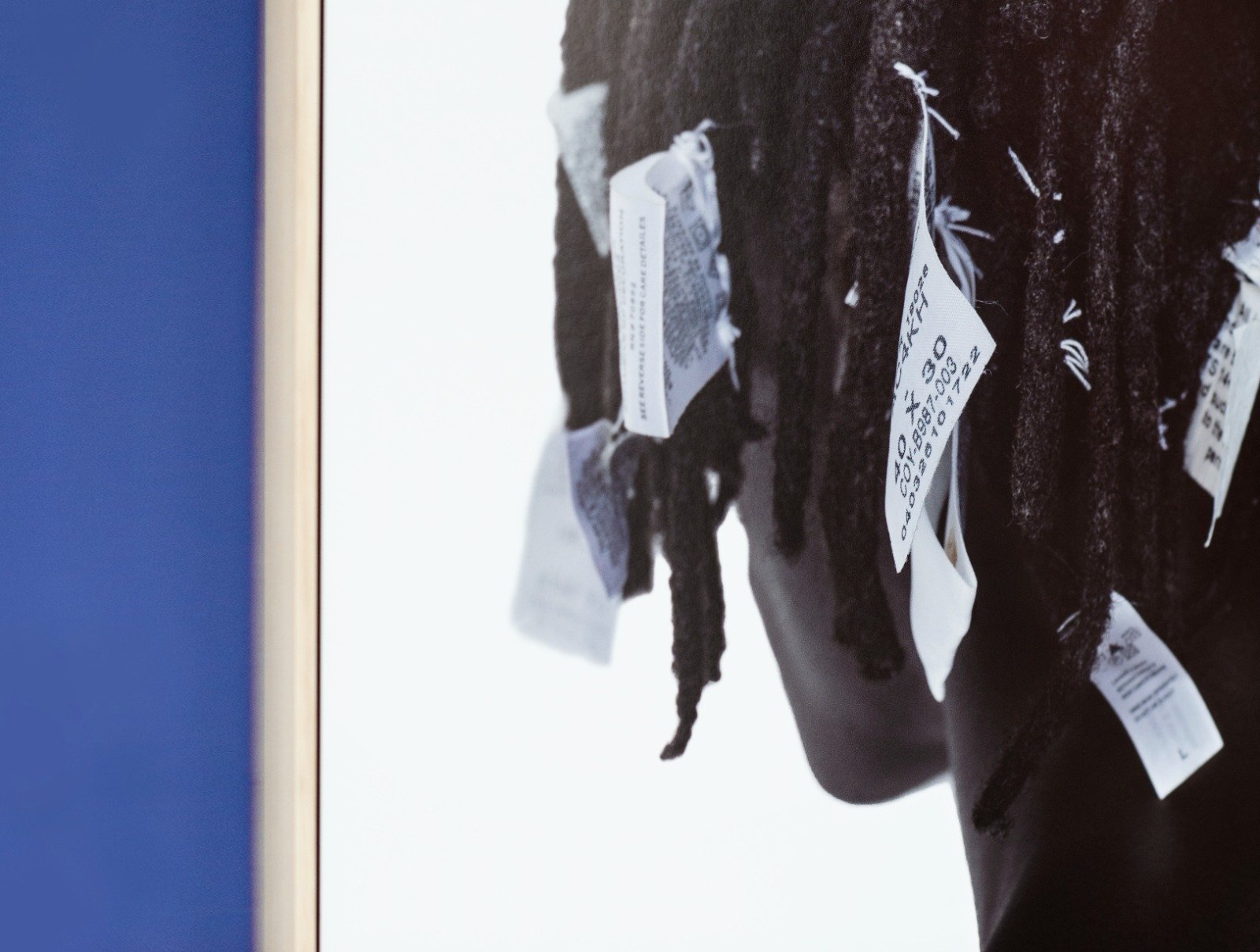Art Antwerp 2023
Art Antwerp, Belgium
Booth A26
13 - 17 December 2023
Alan Hernández
Sam Samiee
NMAG’s participation at Art Antwerp is supported by Mondriaan Fonds.
Art Antwerp 2023, with Alan Hernández and Sam Samiee. Antwerp, Belgium, 2023
Untitled Art Fair Miami Beach 2023
VIEW PREVIEW PORTFOLIO
Untitled Art Fair Miami Beach
5 - 10 December 2023
Booth C17
Afra Eisma
Press:
”Untitled Art Review: An Exuberant Fair in Miami Beach”, The Wall Street Journal, Brian Kelly, 2023
”A look at some incredible art you can see at Miami Art Week”, Miami Herald, 2023
"Artistic Director Omar López-Chahoud picks his favorite artworks at Untitled", SURFACE, Ryan Waddoups
Interview on Artsy
NMAG’s participation at Untitled Miami Beach is supported by Mondriaan Fonds.
Solo booth Afra Eisma with No Man’s Art Gallery at Untitled Art, Miami Beach, 2023
Taking acorns amongst the stars, 2023, acrylic yarn and polyester backing, latex, 300 x 387 cm. Photo: Gert Jan Van Rooij
Solo booth Afra Eisma with No Man’s Art Gallery at Untitled Art, Miami Beach, 2023
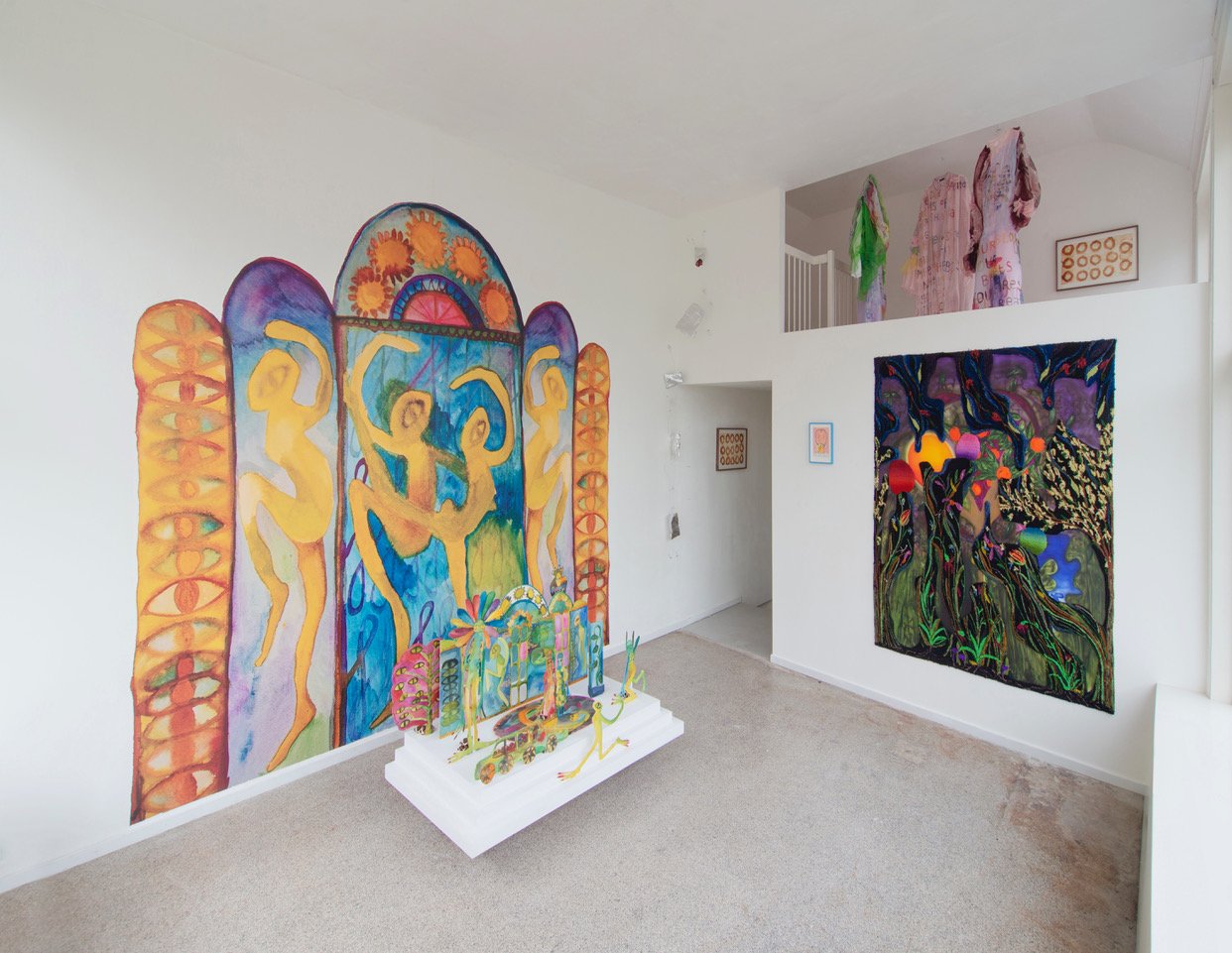
suckle and squeeze | Curated by Afra Eisma
online catalogue
Nadie BorGgreve | Julia Dahee hong | Afra Eisma
Alejandra LÓpez Martínez | Marnix van Uum
22.11 - 23.12 2023
Opening
Wednesday November 22nd from 4 - 6 pm
Location: NMAG Kiosk, Willem de Zwijgerlaan, 327, Amsterdam
In the midst of winter’s solace, and the need for i-love-you’s, No Man’s Art Gallery presents the group exhibition suckle and squeeze. This friendship, this friendly-ship, that vessel in which I camouflage. Their arms warm to hold me, boundaries bound anew as my body is boarded. I’m melted into a confusing mixture; home. Outside it’s no different, in a circle – our arms one. ‘Do not remove your lovely leopard spots’, she said. We squeezed milk in each other's mouth as they came out.
Photos by Neeltje de Vries

The Wormhole Echoes | Curated by Megan Irusta Cornet
online catalogue
Anna Vosse Carpaij | Lotus Rosalina Hebbing
Matei Dragomir | Obbe van der Weide
Toran Macrae Wolstencroft
22.11 - 23.12 2023
Opening
Wednesday November 22nd from 4 - 6 pm
Location: NMAG, Bos en Lommerweg, 88, Amsterdam
jiuba art space presents Wormhole Echoes. In Roman mythology, Janus, the god with two heads, embodies the dual nature of holding conflicting ideas. A symbol of beginnings and endings, doorways, openings and time; the plurality of openings highlighting the freedom of choice. Wormhole Echoes is an exploration beyond the confines of our chosen perspectives, echoing duality and it inspires us to seek a deeper understanding of the universe and our place within it.
jiuba art space is an is an offshoot of No Man’s Art Gallery, providing a space for spontaneous, joyful and experimental programming on an informal basis with young and emerging artists. As a mostly online space, jiuba will function as an accessible art marketplace that will have occasional physical expressions such as this show.
Photos by Neeltje de Vries

When Hell Breaks Loose I’ll Tell You Your Legs Were Always On My Mind | Sam Samiee
Listen back to the artist talk with artist Sam Samiee and director/curator Lih-Lan Wong
NMAG Storage Sessions I
08.09 - 29.10. 2023
No Man’s Art Gallery proudly presents When Hell Breaks Loose I’ll Tell You Your Legs Were Always On My Mind the first solo exhibition by Sam Samiee at the gallery. Across his multifaceted career as a painter, essayist and psychoanalyst in-training, this exhibition specifically highlights the artist’s sixteen-year engagement in drawing, emphasising the prioritisation of queer aesthetics throughout vulnerabilities and crises.
The rooms of No Man’s Art Gallery show over two-hundred rarely exhibited drawings - spanning from 2008 - 2023 - that are thematically divided into landscape and flora, imaginative scenes, figuration and still life. The title of the exhibition alludes to an overarching theme throughout the artist's artistic and research-based endeavours: voicing a poetic eroticism or playfulness in the light of crises.
Samiee refers to his practice as post-cinematic. Central to his practice are installations embedded within the architecture of the exhibition space. The way they are edited relate to the process of playing with semantics. An example of this is seen in relation to his models, friends and conversants, revealing a deep connection of shared moments and dialogue that influenced sensual, political and relational elements guided by the artist's long involvement in psychoanalytic settings and thinking.
While Samiee separates and engages independently with drawing as a rationalist enterprise of measuring and recording the real world, his other endeavour, poetry and deconstruction of language, intertwines as subject matter of the drawings. Drawing and visual arts are put to work to materialise notions, concepts and abstract constellations that have seemingly lost their touch with materiality. Finding life-driven forces within situations that are deadening; finding a playfulness at the moment of drawing still life, machines and objects of everyday life; envisioning familiar and unfamiliar landscapes of mountains and lowlands, and collecting thoughts and ideas for a future view. Through the unique installation of the drawing archive, new connections appear between nodal points of the works.
His drawings breathe life into verses from poetry, figures from world mythology, and his own lines, avoiding mere literary illustration. An abstract scene of a lover's embrace is interlaced with a written fragment of Mohammad Reza Sharjarian's "A Lover's Plight," a Persian song calling on lovers to pour their hearts into their cups like tulips blushing. Samiee's recurring exploration of the connection between a verse of poetry and drawing or painting such as in his use of the promethean motif, leads to fresh interpretations and interconnectedness among these semantic points.
Amid over two hundred drawings we find scenes of mourning, death, the crucifixion and Iran-Iraq war tragedies yet always with the presence of the sanctuary that is beauty. The drawings invite access to the subtext of Samiee’s oeuvre, as amongst the chaos it is the beautiful thighs, chests, the Mountains Zagros Ranges and the blossoming orchid branch that offer solace.
Seen from a chronological point of view, and if compared with the exhibiting trajectory of the artist, one is able to observe how Samiee challenges literary hegemony within his culture and others by infusing architecture, physicality, color, and line into a playful discourse. His work exposes and puts on trial ideologies that regulate bodies, allowing both himself and viewers to confront the material reality of his subjects. In his more recent drawings, an embrace of the decorative and the poetic become increasingly visible.
When Hell Breaks Loose I'll Tell You Your Legs Were Always On My Mind reveals a decade of the backstage of the artist practice, research, obsessions, tests and notes which hold together a wide range of emotions, fantasies, and ideas that Samiee has relied on or will return to in the future of his ongoing explorations.
The opening is followed by NMAG’s 5 Year Anniversary Party from 9pm onwards. Join the celebration at Bos & Lommerweg 88 with cocktails and music late into the night.
Public Programme:
Artist Talk | Sam Samiee in conversation with Lih-Lan Wong
When: Thursday October 26th 2023
Time: 6pm - 8pm
Location: NMAG & de bar, Bos en Lommerweg 88-90, Amsterdam
Painter, essayist and psychoanalyst in training Sam Samiee will give an artist talk in conversation with director and curator Lih-Lan Wong.
RSVP to Artist Talk (free admission)
Photos: Tommy Smits
Sam Samiee in his solo booth on Art Rotterdam 2023, by Lucas Marcus Schilder
Sam Samiee (b. 1988, IR) is a painter, essayist and psychoanalyst in training based in Amsterdam, Berlin and Tehran. He is a winner of the Royal Award for Painting in 2016 and Wolvecamp Prize in 2018 and finished the Rijksakademie residency in 2015 and ArtEZ University of Arts and Design in 2013, where he was a lecturer of painting until 2020. Samiee synthesises his heavy research on art history, Persian poetry and psychoanalytic theories into a studio practice that employs painting in multiple registers. The characteristic of his installations as extended paintings is the break from the tradition of flat painting and a return to the original question of how artists can represent the three-dimensional world in the space of painting as a metaphor for a set of ideas. He employs a range of painterly attitudes from oil paintings to iPad paintings, figuration, abstraction, the break of the rectangular frame and usage of text among other methods. Recently Samiee’s work focuses on a period of painting that parted ways from avant-garde, with the emphasis on decorative modes of work, of artists such as Matisse and Bonnard.
Graphic Design: Peter van den Hoogen (Coup)

jiuba art space presents: Atari | Summer Show
Online Catalogue
Anico mostert | Anna van der Ploeg | Cihad Caner | Donglai Meng | Esther van der Heijden & Nosh neneh | kelvin Dijk | Merijn KaVelaars | Safira Taylor | Sam Samiee | Sisse Holst Pedersen | Tommy Smits
Atari
A group exhibition by jiuba art space, hosted at No Man’s Art Gallery
Curated by Sophie Huijbregts
21 July - 27 August 2023
No Man’s Art Gallery is proud to present Atari, a group exhibition that brings together 12 artists whose work inhabits a state of atari: a moment suspended in time, in which the next move must be made. Atari invites us to visit a series of crossroads, touching on topics of interconnectedness and competition, precarity and growth.
In the ancient game of Go, the concept of atari refers to a situation in which a stone is left with only one remaining liberty, or one empty intersection adjacent to the stone. It occurs when a stone’s liberties are reduced to one, caused by the position of the opponent’s stones - meaning the player is faced with the imminent loss of their stone and territory. Therefore, their next move directly and consciously impacts the further path of the game. They can make several strategic decisions, such as defence, counterattack and sacrifice. By recognising atari and responding appropriately, players can either secure their stones' safety or capitalise on their opponent's position to gain an advantage in the game.
Being in a state of atari requires us to hold the weight of all possible paths forward in a single moment: it is a state of contemplation. This is beautifully illustrated in works such as those by Anico Mostert and Donglai Meng. They are meditations, showing us hope and fear and highlighting the multifaceted nature of the human response to risk. At the same time risk can be seen as a catalyst for change, as we can recognise in the works by Sisse Holst Pedersen and Esther van der Heijden. They fuse resilience with fragility, communicating on interconnectedness and growth.
Atari entails the imminent loss or potential gain of territory. This tension evokes a sense of vulnerability, speaking to the role of physical space in the construction of identity and ideas of belonging. In Studies in Cartography, Sam Samiee investigates the power structures at play in the seemingly neutral practice of mapping, drawing attention to the violence underlying this act of capture through imagemaking. It works to render places and peoples legible, defining sets of hierarchies and relationships through which authority can be exerted. If mapping defines territory to impose structures of power, the transgression of those boundaries can be seen as a threat to that same power. Cihad Caner delves further into the construction of the “other” in relation to processes of migration, illustrating how movement through territory puts pressure on ideas of the self. He focuses on water as a driving ecological and political force, as well as a space of flux and uncertainty. Flows of people give rise to anxieties around belonging, their mobility eroding false notions of permanence and stability.
As the moment in which a path must be chosen, atari is also a state of suspension and uncertainty. Kelvin Dijk’s work grapples with the interplay between migration and identity on a personal level, addressing internal feelings of displacement. Through the exploration of (visual) culture and lore, he attempts to connect different localities and create new modes of cultural belonging. A similar act of anchoring oneself in the face of uncertainty can be found in Anna van der Ploeg’s abstractions of Cape Town’s “missing” posters. They are highly localised communications, as an anonymous author sends out a cry for help to those sharing an urban landscape. These strategies can be seen as acts of tracing, of rendering visible networks and connections across space and time. Similarly, Tommy Smits’ works are a testimony to one of many possible paths taken. They embody a series of uncertainties, a chain reaction of decisions made by chance, memorialising each one as fossils in stone.
If the situation at hand is dealt with strategically, atari represents the possibility for gain or growth. Living Monuments of the Deep, a collaborative project between Esther van der Heijden and Nosh Neneh, makes a case for applying such contemplation and awareness to our relationship with the natural world. The works seek to embody the vulnerability of endangered oceanic species, and invite us to cherish the vast interconnectedness of the world we inhabit. In a similar vein, Safira Taylor combines personal histories with fluid interpretations of the vulnerability, growth and interdependence which characterise many organic processes. This cyclical nature can be recognised in Merijn Kavelaar’s 4Flux, which revisits canvasses from past creative processes to fuel new artistic growth.
Atari marks the launch of jiuba art space, a new (online) space for experimentation and play. jiuba is an offshoot of No Man’s Art Gallery, providing a space for spontaneous, joyful and experimental programming on an informal basis with young and emerging artists. As a mostly online space, jiuba will function as an accessible art marketplace that will have occasional physical expressions such as this show.
Atari will be on show from July 22nd until August 27th. The exhibition extends across both gallery locations: No Man’s Art Gallery KIOSK (Willem de Zwijgerlaan 327), open Wednesday through Saturday, 12 - 5pm. No Man’s Art Gallery & de bar (Bos en Lommerweg 88): open daily, 12 - 5pm.
Programme:
Guided tour with curator Sophie Huijbregts and artists
Location: No Man’s Art Gallery KIOSK, Willem de Zwijgerlaan 327
When: Thursday, August 24th
Time: 6 - 10 PM
Photos: Peter Tijhuis
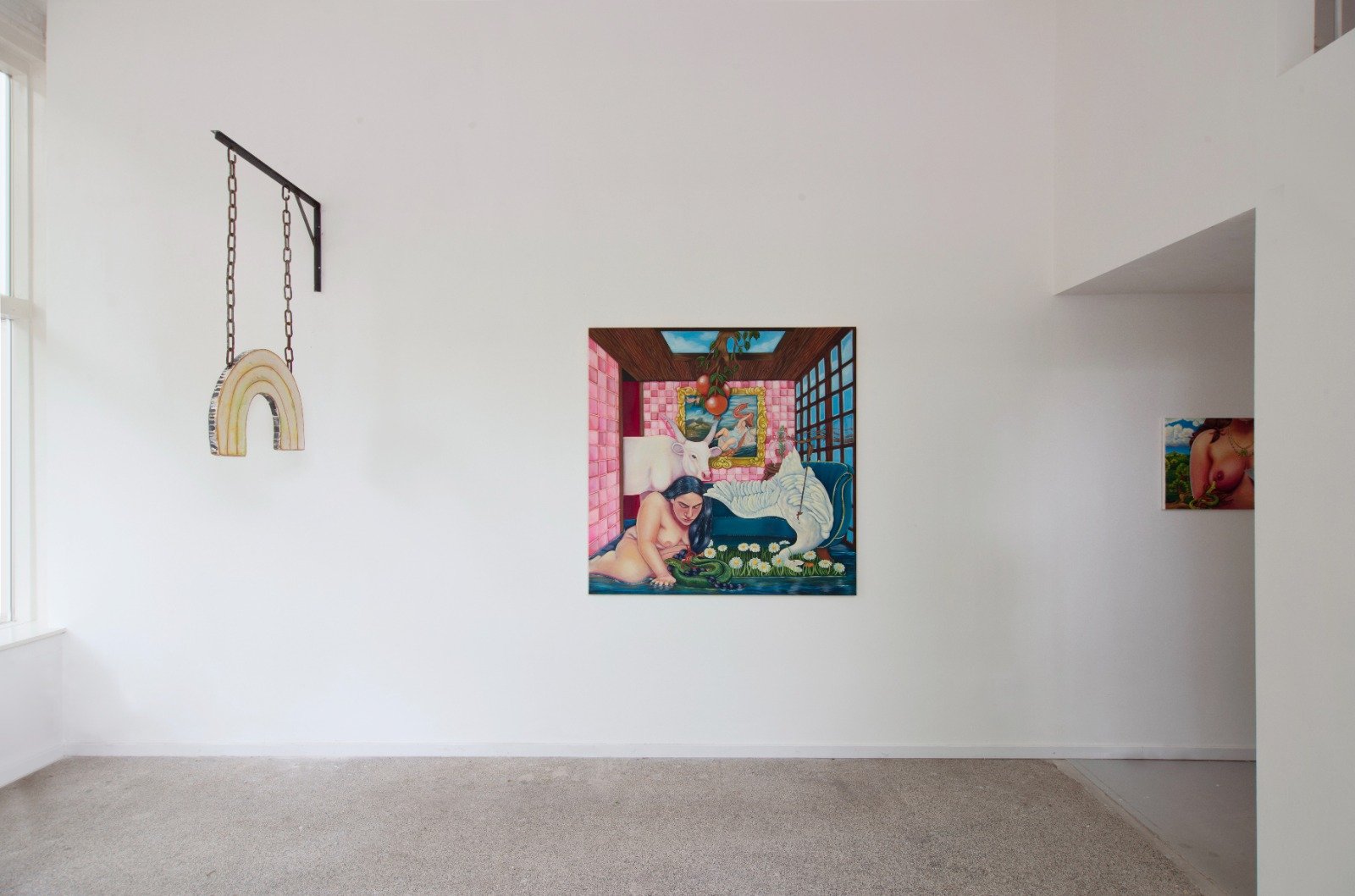
Las estrellas me iluminan al revés | Group Show
Online Catalogue
José Eduardo Barajas | Wendy Cabrera Rubio | Alejandro Galván | Alan Hernández | Alejandra España | Chavis Mármol |
Carlos Martínez González | Ileana Moreno |
RojoNegro (Noé Martínez Flores & María Sosa) |
Rodrigo Red Sandoval | María Sosa | María Vez
Las estrellas me iluminan al revés
June 2 - July 15 2023
Opening Friday June 2nd 4 - 7 PM at both gallery locations
No Man’s Art Gallery is honoured to participate in Amsterdam Art Week with the exhibition “Las estrellas me iluminan al revés”, featuring a diverse collection of works by emerging Mexican artists. The group show is an extension of the gallery’s tenth international pop-up gallery in Mexico City and opens June 2nd at both gallery locations in Amsterdam.
“Las estrellas me iluminan al revés,” includes works by José Eduardo Barajas, Wendy Cabrera Rubio, Alejandro Galván, Alan Hernández, Alejandra España, Chavis Mármol, Carlos Martínez González, Ileana Moreno, RojoNegro (Noé Martínez Flores & María Sosa), Rodrigo Red Sandoval, María Sosa and María Vez.
“Las estrellas me iluminan al revés” invites twelve artists to explore the inevitability of spirituality as a strategy to cope with the darker forces of life. Each work attempts to touch the realms of duality, magic or healing; relating to itself while at the same time being charged by external sources that are of more obscure nature.
The exhibition title, roughly translated as “the stars shine on me backwards,” takes its inspiration from the largest painting in the show by Alejandro Galván. The painting references the lyrics of Alfredo Guttiérez's "El Solitario," a renowned cumbia song portraying the unfortunate life of a desolate drunkard, to whom misfortune has become a constant companion. His melancholic existence is felt as if the stars have illuminated him in reverse. Having given up on life, the man preserves a sense of pride by attributing his misfortune to a reversed starlu.
All of the works in the exhibition carry a similar charge of an elusive dark energy, each time conjured by another force: ancestors, symbols, mythical gods, astronomy, rituals or witchcraft. They prolong the natural movement and oral histories of magic that tie the intricate Hispanic, Indigenous, and African cultures of Central America and beyond.
“Las estrellas me iluminan al revés” opens on June 2nd at 4pm and runs until 16 July 2023 on both gallery locations: Willem de Zwijgerlaan 327 and Bos & Lommerweg 88, Amsterdam.
Photos: Neeltje de Vries

ONCE THERE WAS (N)ONE | Curated by Fereshte Moosavi
Online Catalogue
Khosrow Hassanzadeh
Mina Keshavarz
Sanaz Sohrabi
Ramtin Zad
ONCE THERE WAS (N)ONE
Opening Tuesday 25 April 2023 from 5 - 8PM
25 April - 16 May 2023
Curated by Fereshte Moosavi
Amid times of ongoing cruelty, normalized violence, and never-ending war, this exhibition presents a number of artworks that counter the historical forgetfulness caused by such conflicts. Each artwork creates a monumental presence for the erased, oppressed, or marginalized beings and things. This is realized by combining the power of factual narratives with fictional tales that are founded on actual documentations, family archives as well as imaginary situations. The artworks include painting, drawing, sculpture, print, video and documentary by Khosrow Hassanzadeh, Mina Keshavarz, Sanaz Sohrabi and Ramtin Zad.
The Art of Living in Danger (2020) is a documentary by Mina Keshavarz that revolves around a monologue that the artist has written to her grandmother, Nuri, who she’s never met. Pressured by the traditional marriage at a young age, Nuri commits suicide at the age of thirty-five when pregnant with her eighth child. Made on the fiftieth anniversary of Nuri’s death, this film is an act of remembrance and a homage to Keshavarz’s grandmother as one of the many women whose life is affected by domestic violence. In the meantime, by following a group of female lawyers and activists in their campaign for criminalisation of domestic violence, Keshavarz documents the ongoing fight for gender equality and for ending normalized violence in Iran. With a similar approach, Khosrow Hassanzadeh’s Faheshe (2001) is a series of silk screen prints portraying a number of women who were victims of a chain murders in the city of Mashahd, north east of Iran over twenty years ago. By employing police documentations to print large, colorful and repetitive portraits of these women, not only Hassanzadeh challenges the ‘distorted ideology behind the criminal’s fundamentalist motivation’, but also, he creates a monumental appearance for these women as an act of remembrance.
These works are set against the backdrop of politically charged historical references that set a reminder of the bitterness of dominant states’ powers. Ramtin Zad’s series of paintings and drawings titled Last Ceremony (2018-2022) brings together a more dramatic and expressive presentation of the momentum of death, intertwined with political and fictional figures. His short video Smile Parade (2018) is an anti-monumental work in which he paints a clown portrait over every single face of the North-Koren and Russian armies while marching at an unknown special event. In continuation of questioning the long-established moral principles, counter-monuments are a way to reflect on the monuments’ message or lack thereof to reread history. Sanaz Sohrabi’s video art The Glory, the Human, and the Mother; a Cartography (2017) sets out on a journey to different locations of the former soviet union to search for three monuments that were demolished, altered or repurposed. Moving between the archival materials and documentations from the sites of the statuses we hear the artist's narration about the events that surround these monuments.
Image: The Glory, the Human, and the Mother: a Cartography, 2017, (film still), Sanaz Sohrabi, Video with sound, 17:35 minutes

SPECTRUM | Jamal Nxedlana
Press:
- Weekendtips van Mitchell Esajas: SPECTRUM by Jamal Nxedlana, Het Parool, 2023
- Elle Decoration, Mexico, 2024
SPECTRUM
Opening Saturday March 11 / 5 - 8 PM
11 March - 16 April 2023
Artist Talk with Jamal Nxedlana
Thursday April 6th / 6 - 8 PM
RSVP (free admission)
No Man’s Art Gallery is honoured to present SPECTRUM, the second solo exhibition by Jamal Nxedlana at the gallery. The exhibition showcases a new series of images that continues his exploration of topics such as race, masculinity, post-colonialism and consumer culture, with a particular focus on the representation of the black body in fashion photography. Nxedlana is a visual artist and cultural organizer who is recognized for establishing initiatives and projects that support the South African arts community, including Bubblegum Club, a digital platform and culture agency that promotes innovative work and emerging cultural workers.
His first solo exhibition at No Man's Art Gallery, AVATAR, celebrated the creativity of Johannesburg's cultural scene, using their work and personal style as statements of mystery and beauty. Nxedlana created a mythology in which new gods and spirits emerge from a moment in the city’s history (2016-2019) where Nxedlana felt in sync with his contemporaries. While his subsequent global exhibitions garnered attention, the lens through which his work was viewed failed to recognize its multifaceted nature. SPECTRUM examines black portraiture and the artist's path towards abstraction of the black body, presenting a complex series of photographs that resists any singular perspective on black identity.
In SPECTRUM, Nxedlana continues to refine a visual language that incorporates and reflects on objects that are ubiquitous to his context, such as the monobloc chair. It functions as a symbol in itself, but it also appears in dialogue with the artist, recognising the chair as contextually problematic; its provenance suggestive of the unsustainable relationship between the African continent and the rest of the world. “A dumping ground” for cheap products, plastic, clothes; what the world doesn’t seem to want or need anymore. Simultaneously, the omnipresence of the chair has caused it to become part of the visual culture of the artist. The chair reflects the multiplicity of meanings and values encountered along the route of limitlessness and abstraction. A contraction that turns one object into a mindful discussion on identity and questions a tangible encapsulation of the Black experience. “The chair is a way to speak to multiplicity”.
Experimental manipulations with translucent perspex create a prism effect that further informs of the dimensionality and separational nature of the work.. The perspex reflects the shapes of the city of Johannesburg and further entangles the bodies that hold it up. The shape mimics some of the properties of the monobloc chair and enters a symbolic space that allows it to extract abstraction and expression from the deconstructed bodies and objects. The careful combination of these elements provides presented scenes with a wonderfully sharp sculptural quality. Overlapping, layered, and intangible, Nxedlana brings together different symbolic elements and plays with their potential in a way that results in an patchwork organism that can be at any point spotlighted and broken apart into limbs.
Location: NMAG KIOSK, Willem de Zwijgerlaan 327 and NMAG, Bos & Lommerweg 88 (this exhibition extends to both gallery locations)
Photos: Neeltje de Vries
Jamal Nxedlana (b. 1985, South Africa) is a visual artist and cultural organiser living and working in Johannesburg, South Africa. He is the founder of a number of independent organisations that support the South African arts community among which is Bubblegum Club, a digital platform and culture agency showcasing innovative new work and creating opportunities for emerging cultural workers. He is also a founding member of CUSS Group, a Johannesburg-based artist collective that has been exploring the hybrid culture of post-colonial South Africa over the past decade. As a solo artist, his practice addresses the portrayal of the black body in fashion photography while exploring themes of race, masculinity, post-colonialism and consumer culture.
Jamal Nxedlana has exhibited in galleries, institutions and independent spaces internationally. Most recently, his images were featured in the collective shows The New Black Vanguard curated by Antwaun Sargent and Orlando curated by Tilda Swinton.
Jamal Nxedlana by Senay Berhe

Art Rotterdam 2023
Art Rotterdam
8 - 12 Feb 2023
Booth 47, Solo / Duo Section
Sam Samiee
No Man's Art Gallery is honoured to present 'Footnotes to Life', a solo presentation by Sam Samiee (1988, IR), titled after his eponymous artist book. 'Footnotes to Life' brings together Samiee’s multifaceted practice of the last three years which crystallised in a new series of (extended) paintings that embraces the uncertain and decorative as a mode of painting.
Press:
#MeettheArtist: Sam Samiee, by Wouter van den Eijkel, Gallery Viewer, 2023
Art Rotterdam 2023 - 10 Art Works You Really Want To See, Interiorator, 2023
ONLINE CATALOGUE
The Undulations of Contingency, 2022, Acrylic on canvas, 98 x 132 cm. Photo: Gert Jan Van Rooij
Sam Samiee ‘Footnotes to Life’, Solo Booth documentation, Art Rotterdam 2023
Sam Samiee ‘Footnotes to Life’, Solo Booth documentation, Art Rotterdam 2023
Untitled, 2022, acrylics on canvas, 147 x 112,5 cm. Photo: Gert Jan van Rooij
Sam Samiee ‘Footnotes to Life’, Solo Booth documentation, Art Rotterdam 2023
Sam Samiee (1988, IR) is a painter, essayist and psychoanalyst in training based in Amsterdam, Berlin and Tehran. He finished the Rijksakademie residency in 2015 and ArtEZ University of Arts and Design in 2013, where he was a lecturer of painting until 2020. His primary education in arts began at the University of Arts in Tehran. Samiee synthesises his heavy research on art history, Persian poetry and psychoanalytic theories into a studio practice that employs painting in multiple registers. The characteristic of his installations as extended paintings is the break from the tradition of flat painting and a return to the original question of how artists can represent the three-dimensional world in the space of painting as a metaphor for a set of ideas. He employs a range of painterly attitudes from oil paintings to iPad paintings, figuration, abstraction, the break of the rectangular frame and usage of text among other methods. Recently Samiee’s work focuses on a period of painting that parted ways from avant-garde, with the emphasis on decorative modes of work, of artists such as Matisse and Bonnard.
Sam Samiee’s works have been exhibited in Kunstinstituut Melly (2022), Gemeentemuseum Den Haag (2018), Berlin Biennale X (2018), Parasol Unit Foundation (2019) and Art Basel Hong Kong (2018). Samiee has finished a two-year residency at Rijksakademie van Beeldende Kunsten (2014-2015, Amsterdam), is a jury member and former winner (2016) of The Royal Dutch Award for Modern Painting and (2018) The Wolvecamp Award for Painting and has been a lecturer at AKI ArtEZ Academy for Art and Design (Enschede, Netherlands) for four years. As a part of the Wolvecamp award for painting Sam Samiee published a monograph titled “Footnotes to Life”, which won him the Best Dutch Book Design in 2020.
Sam Samiee. Photo: Frans Nikkels





